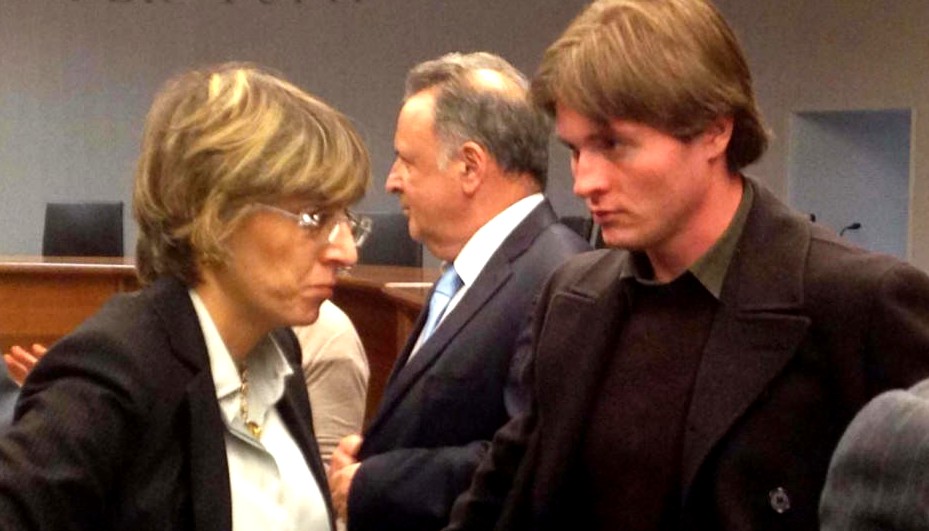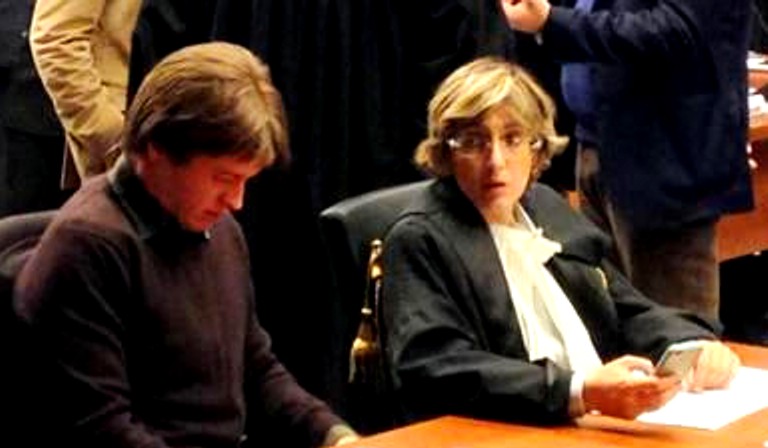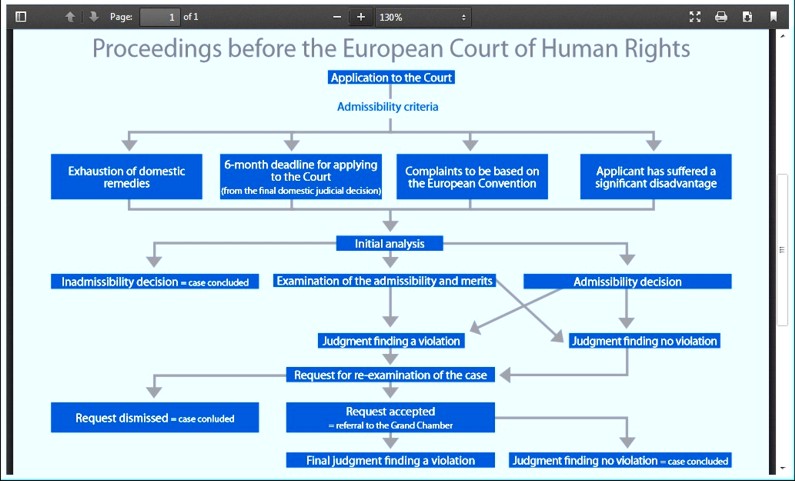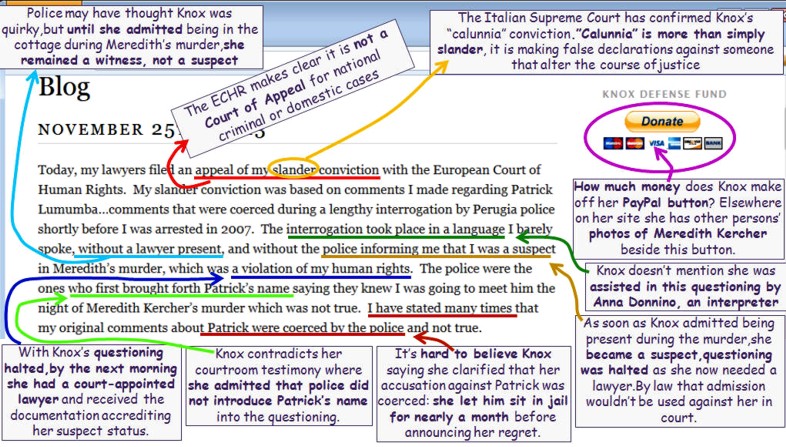
Category: Hoaxes Knox & team
Thursday, December 05, 2013
With Sollecito’s First Plea For Mitigation Seen As A Flop, His Behavior Seems Extremely Suspect
Posted by Peter Quennell

Sollecito headed for Dominican Republic, but stopped pending court okay
1. Post Overview
A week ago Prosecutor Crini had begun a two-day summary of the state’s case so stark and implacable that it had two effects on Sollecito.
He stayed in his hotel on the second day; and he then took off like a rabbit for some destination initially unknown and repeatedly lied-about by his father (see Part 3 below).
One of his lawyers (accidentally?) broke the secret. Sollecito had flown to the Dominican Republic. Where he just happens to have some really unsavory relatives.
2. High Drama In The Nencini Court
Sollecito has not ever taken the witness stand.
And given the minefield his foolish book and media claims amount to, don’t hold your breath expecting otherwise soon. However, last month Sollecito did use the Italian accuseds’ privilege of making an impromptu plea to the judges.
He was not under oath and not subject to cross-examination by the prosecutors. He did not address the copious evidence, and was seen as attempting to humanize himself to perhaps get some years knocked off a final sentence.
As always, Knox forces were left confused, thinking he had somehow helped both of them. But Sollecito repeatedly drew attention to his being an Italian and in effect to Knox and Guede not being Italians, thus once again separating himself from Knox on lines Barbie Nadeau also described here..
Our main poster Yummi was in the court and reported in part as follows:
One of the woman judges kept staring elsewhere and almost never watched Sollecito all the time he was talking. Sollecito’s speech itself was actually not that exciting. It was so overt that he was focused on portraying himself as a person who is so good and cannot hurt anyone, not the bad guy described in the media. The real and only topic of Sollecito’s statement was himself, who he is, his “true” personality, he begged them to look at what a good and suffering a boy he is…
And believe me, Sollecito was just whiny. For a big part of his speech he was just putting distance between who he is today and the person he was when he was 20 years old. He talked about the impossibility of finding a job (the job he would like to have in a corporation, obviously, not just any job) and wanted the judge to project to his condition from that of young Italians who can’t hope to see a future.
Then 10 days ago the skilled senior prosecutor Dr Alessandro Crini fired back, and effectively demolished Sollecito’s premature statement. As we reported, Dr Crini took nearly two days to do that.
Sollecito was again in court on the first day, but was seemingly unable to face Dr Crini’s onslaught on the second day. He remained holed up at his hotel.
Although Dr Crini settled on a lowest-common-denominator motive - a Lord of the Flies flare-up which had escalated into mob violence and the fatal stab to Meredith - his recounting of the evidence and associated behavior of the pack was comprehensive and very hard. Translated from Cronaca:
Meredith was treated “as if she was an animal.” In this way Dr Crini defined the dynamics of the murder of Meredith Kercher during his indictment.
According to Dr Crini, the attack escalated to the point where the attackers felt they “needed to get rid of a girl they had abused”. While Rudy Guede sexually abused Meredith Kercher, supine on the floor of her room, Raffaele Sollecito and Amanda Knox, according to the reconstruction, were at each side of the body of the victim.
“The mouth and neck of the victim were contained in a fierce way to avoid Meredith going berserk and screaming, and when Meredith did in fact manage to scream, she received the final fierce stab to the throat.” Two knives were used in the crime at the house in Via della Pergola on the night between 1 and 2 November 2007”...
Dr Crini referring to the bra clasp of the victim, said that “the presence of the DNA of Raffaele Sollecito is quite certain” and explained at length why there was no “possibility of contamination”.
Amanda Knox was at the scene of the crime, according to the identification made “‹”‹by the scientific police in Meredith’s room of an imprint of a shoe (female size 36-38 according to the results of the analysis)... On the pillowcase, the center of gravity of this bloody history, were found a palmprint of Rudy Guede and this print of the shoe.”
3. High Drama Right After End Of Court
Dr Francesco Sollecito was reported as being shocked by the unrelenting tone of the indictment. However, Sollecito’s plight is not nearly as bad as the ever-stubborn Amanda Knox’s.
Knox has already served three years and was fined heavily for obstruction of justice. She could face another year for that if it is found to have been aggravating. And as the post below mentions, she could face as many as three more charges for aggravating obstruction of justice.
Sollecito in contrast has respected the court by actually showing up, and, unlike Knox, has lately shown restraint in accusing his accusers.
However, the day after Dr Crini ‘s startlingly powerful summary of the case against him, it looked like Sollecito was hastily taking off out of Italy for somewhere.
La Nazione reported that police at Florence Airport had held back a fully loaded Air France flight to Paris while they checked with the prosecution that he was indeed allowed to leave the country. La Nazione said the prosecutors have some concern that he might skip and not come back, but he did voluntarily come back previously from the Dominican Republic, and his family has always ensured some presence in court.
But next TGCom24 reported that Sollecito’s father had claimed that Sollecito had already gone home to Bisceglie, although he is a free citizen still in possession of a passport and can travel anywhere if he wishes.
But then TGCom24 reported that he had indeed flown to Paris, but had turned around and come straight back again, to stay with family friends. And that on 8 December he will sit his final exams in computer science at the University of Verona.
However, soon after that La Nazione reported that Sollecito’s father had been contradicted by his lawyers, and his erratic son had slipped through his fingers and flown “for his work” back to the Dominican Republic. Translation by Jools:
1 December 2013 ““ SCOOP. Denials, lies, game by the defenders. But in the end it’s up to the lawyer Luca Maori to admit: “Raffaele Sollecito returned to Santo Domingo, as anticipated on Friday by La Nazione”
He embarked from Florence’s Peretola Airport and made a stop-over in Paris, from where he then flew to the Caribbean island where he spent the last few months that preceded the start of the new appeals process. “But there is nothing strange - minimizes the lawyer - Raffaele went back to pick up the things he left there, will be back in ten days for the final exams and to await the judgment. With anxiety, but self-assured.”
No escape, just a normal “work” trip. Permissible, since there is no measure that prevents the accused to leave Italy. But the departure of Sollecito, accused of the murder of Meredith Kercher along with former girlfriend Amanda Knox (already sheltered in the U.S.) caused some sneering. And even the agents of the Border Police, when they saw him in front of the [departure] gate, made a phone call to the Procura to be sure whether the journey in the midst of the appeal process was really “normal.”
IN FACT. Sollecito ‘s father, in an understandable effort to defend his already too overexposed son, slipped on the so-called banana peel, placing the young man within a few hours in various locations, but never in the true destination across the ocean: in Verona, preparing for the final exam in computer science in regard to the thesis, or in Paris, but just for a flash-stay from which he was back the day after. At Christmas, maintained the father, Raffaele will return from abroad. Maybe for the last break before the final rush of the Mark II process, which, according to calculations by the Assize Court of Appeal, could be concluded on January 15.
Meanwhile, the hearing on 16 December is for the remaining civil parties, then double date for the defence, (December 17 and January 9) and hearing on the 10 dedicated to counter-argument. With Sollecito in the courtroom, assures the lawyer.
Nothing strange?! Doctor Sollecito lying repeatedly, instead of explaining to the media where Raffaele went, and why he went there, and why it was a huge secret, was VERY strange.
It should have official minds very seriously wondering why. WHAT did Raffaele have to do so secretly in the Dominican Republic - where his notorious mafia relatives from Montreal occupy a town there?
Monday, December 02, 2013
A Second Analysis Of Amanda Knox’s Email To Family And Friends Of 4 November 2007 DRAFT
Posted by Peter Quennell
I have been trawling through Knox’s infamous email that she wrote to her “friends” in the US shortly after she had cruelly murdered poor Meredith. Here are my thoughts - apologies to all if I am covering old ground.
I have interspersed Knox’s email record, (as she had written it), with my own comments. Hope they are useful to TJMK’s fight for justice for Meredith.
Email by Amanda Knox
This is an email for everyone, because I’d like to get it all out and not have to repeat myself a hundred times like I’ve been having to do at the police station. Some of you already know some things, some of you know nothing.
This reads as if Knox is establishing an alibi and a chronology from the outset. The structure is an odd mix of quasi-formality and off the cuff anecdote.
She does not feel the need to explain why she has had to repeat herself a hundred times at the police station. After all, an innocent person would tell the truth once, with perhaps minor corrections. Only a person, like Knox, who was changing her story to the police so often, would need to repeat herself endlessly. By default, therefore, she is admitting that her story is proving unbelievable, so this email is her attempt to garner psychological support and credence from her family and friends in the US.
What I’m about to say, I can’t say to journalists or newspapers and I require that of anyone receiving this information as well.
Here and repeated further on in this email, Knox is blatantly breaching the strict advice that she remains publicly silent, particularly in relation to the media. She has no control over this email “information”, once she has sent it to her multiple recipients, because she cannot be sure that it will not leak to third parties.
This is my account of how I found my roommate, murdered, the morning of Friday, November 2nd.
Strictly formal in style, much as one would expect of a written statement to the police. Knox seeks to assuage her psychological turmoil and gain mental control because she knows she has repeatedly lied to the police and none has yet, (understandably), believed her.
The last time I saw Meredith, 22, English, beautiful, funny, was when I came home from spending the night at a friend’s house.
The insertion of “22, English, beautiful, funny” seems completely inappropriate in relation to a recently, brutally murdered Meredith. It reads as if a third-rate novelist is introducing a key character. Thus Knox reveals her email to be a self-serving, imaginary construct ““ not factual and honest, as an innocent person would write.
It was the day after Halloween, Thursday. I got home and she was still asleep, but after I had taken a shower and was fumbling around the kitchen, she emerged from her room with the blood of her costume (vampire) still dripping down her chin.
Showers, in this email, seem to be a major obsession for Knox. Could she be trying to wash away her oppressive psychological feelings of guilt?
We talked for a while in the kitchen, how the night went, what our plans were for the day, nothing out of the ordinary”¦..,
Why should Knox note, “Nothing out of the ordinary” in this routine conversation, other than she is trying to paint a benign landscape of her relationship with Meredith? (In fact, we know from independent witnesses that Meredith had become increasingly annoyed by Knox’s anti-social behaviour around the house)
“¦and I began to start eating a little, while i waited for my friend (Raffaele-at whose house i stayed over) to arrive at my house. He came right after I started eating and he made himself some pasta.
Note Knox’s truly strange attention to detail, “I began to start eating a little” and “He came right after I started eating”. Why the almost millisecond importance of eating? I believe that Knox is highlighting the timing of Sollecito’s arrival to establish that they were therefore together when Meredith was alive and that they remained so until her body would be discovered. This seeks to build an apparently highly accurate and continuous chronology for their alibi.
As we were eating together, Meredith came out of the shower and grabbed some laundry or put some laundry in, one or the other, and returned into her room after saying hi to Raffael
Knox mentions the word “grab” repeatedly throughout this email. It does not signify a factual rush to do something, but her psychological need to create a fleeting impression about recollections that she knows to be untrue.
It is also odd that Knox feels the need to highlight the “laundry”, but is immediately vague on whether or not it was before or after the wash. This is the sort of detail that adds nothing of factual relevance, but tends to create the impression that Knox is making it up as she goes along. Repeatedly, throughout all her statements, she fluctuates between sudden accuracy about certain unimportant facts or those that support her claimed innocence, but becomes, equally suddenly, very “confused” when it relates to important facts that might establish her guilt.
After lunch, I began to play guitar with Raffael and Meredith came out of her room and went to the door. She said bye and left for the day. It was the last time I saw her alive.
This is a very laborious and therefore insincere recall. Most innocent people would simply recall that, “After lunch, Meredith said goodbye and left for the day”. Knox’s attention to detail appears necessary only because she is carefully constructing a knowingly dishonest version of events and placing herself in it, as if she were an innocent spectator.
After a little while of playing guitar, I and Raffael went to his house to watch movies and after, to eat dinner and generally spend the evening and night indoors. We didnt go out.
Once again, Knox takes great care to build a continuous, but dishonest, alibi. She seeks to reassure herself by creating a fantasy narrative, with Sollecito and her as the key actors.
How can one “generally spend the evening and night indoors”? Either they did or they didn’t do so. Period.
Why, if they did stay in, does Knox feel the need to expressly state, “We didn’t go out”?
It would appear that Knox is grappling with her inner knowledge that she is telling whopping great lies, but by repeating them, she can establish the alibi in her mind and also reassure herself, (and the FOA), that she is telling the truth.
The next morning, I woke up around 1030 and after grabbing my few things, I left Raffael’s apartment and walked the five-minute walk back to my house to, once again, take a shower and grab a change of clothes.
As above, we have two instances of “grabbing”, indicating a specific desire to skip quickly across her conscious lies. Knox again stresses a shower, a subconscious effort to cleanse her burdensome knowledge of guilt.
I also needed to grab a mop because, after dinner, Raffael had spilled a lot of water on the floor of his kitchen by accident and didnt have a mop to clean it up.
This is not the first time that Knox alludes to this water issue and therefore, the need to collect the mop from her house. Unfortunately, Sollecito’s and her versions vary between a “spillage” and a “leak” from the sink.
These descriptions mean two different things. A “spillage” indicates a human cause, whereas a leak indicates a failure in the pipes.
Judge Massei has rightly questioned the need to collect a mop from Knox’s house, when Sollecito had a janitor service at his house.
I don’t think anyone on TJFM has suggested a perhaps more likely reason for Knox “grabbing” her mop and taking it to Sollecito’s house, one that has nothing to do with leaks or spillages at the latter house.
We know that there was a concerted clean-up of the murder scene, most likely after Knox had purchased cleaning agents/bleach from the shop, early on the morning of November 2nd 2007. It would make sense that Knox and Sollecito, bare foot, used Knox’s house mop to wash down the floors. It would be potentially very risky to leave that mop at the murder scene thereafter, (no matter how well it was rinsed), for fear that traces of Knox’s and/or Solliceto’s incriminating DNA remained for detection by forensics, mixed with Meredith’s DNA.
It was simply much safer to take the mop away, as they left the house.
It would be interesting to know if the police ever found Knox’s original mop and whether it would have yielded any incriminating DNA evidence.
So, I arrived home and the first abnormal thing I noticed was the door was wide open.
Note: Knox immediately notes that the “wide open” door was “abnormal”.
Here’s the thing about the door to our house:
It’s broken, in such a way that you have to use the keys to keep it closed.
if we dont have the door locked, it is really easy for the wind to
blow the door open and so my roommates and I always have the door
locked unless we are running really quickly to bring the garbage out
or to get something from the neighbors, who live below us.
Who “runs really quickly” to bring garbage out? Only someone like Knox, who is trying to persuade herself and the FOA that it would justify leaving an entrance door “wide open”. Most sensible tenants would have demanded that the landlord repair the door and secure the property, particularly as it housed four young women.
(Another important piece of information: for those who dont know, I inhabit a
house of two stories, of which my three roommates and I share the
second story appartment. there are four Italian guys of our age
between 22 and 26 who live below us. We are all quite good friends and we talk often. Giacomo is especially welcome because he plays guitar with me and Laura, one of my roommates and is, or was, dating Meredith. The other three are Marco, Stefano, and Ricardo.)
Why is this information so “important”, particularly for “those who don’t know”? The only reason seems to be an opportunity for Knox to create the illusion that she was very sociable. We know, according to independent witnesses, that Knox had distinct character quirks that made social contact uncomfortable for all who met her, (bar Solliceto).
Anyway, so the door was wide open. Strange, yes, but not so strange that I really
thought anything about it.
Note: now Knox cannot make up her mind whether the “wide-open” door is “odd/strange” or “not so strange that I really thought anything about it”. The truth is that these expressed reactions are mutually exclusive. Indeed, she goes on immediately to show that she DID think something about it”¦.
I assumed someone in the house was doing exactly what I just said, taking out the trash or talking really quickly to the neighbors downstairs. So I closed the door behind me
but I didnt lock it, assuming that the person who left the door open would like to come back in.
A lot of “thinking” here, all of it a self-serving excuse as to why Knox didn’t call the police straight away.
When I entered, I called out if anyone was there, but no one responded and I assumed that if anyone was there, they were still asleep.
This was another of Knox’s BIG assumptions, taking no care to even consider that there might have been a genuine break-in or that the culprit might be still lurking in the house.
Laura’s door was open which meant she wasn’t home, and Filomena’s door was also closed. My door was open like always and Meredith door was closed, which to me meant she was sleeping.
Knox seems to be so knowledgeable about her housemates’ whereabouts, simply by the status of their respective bedroom doors!
In fact, Knox knew that both Filomena and Laura would be away for the long weekend and that only Meredith would be in the house on 01/11/2007.
I undressed in my room and took a quick shower in one of the two
bathrooms in my house, the one that is right next to Meredith and my
bedrooms, (situated right next to one another).
It was after I stepped out of the shower and onto the mat that I noticed the blood in the
bathroom. It was on the mat I was using to dry my feet and there were
drops of blood in the sink.
At first, I thought the blood might have come from my ears, which I had pierced extensively not too long ago, but then, immediately, I know it wasn’t mine because the stains on the mat
were too big for just droplets from my ear, and when I touched the
blood in the sink it was caked on already.
Who pierces their ears “extensively”? Knox, here, is desperate to try to link bleeding from alleged tiny earlobe punctures with the volume of blood visible in the sink and on the mat.
There was also blood smeared on the faucet. Again, however, I thought it was strange
because my roommates and I are very clean and we wouldn’t leave blood
in the bathroom, but I assumed that perhaps Meredith was having
menstral issues and hadn’t cleaned up yet. Ew, but nothing to worry
about.
Again, lots of “strange” blood that Knox immediately seeks to explain away by careless and indeed ridiculous “menstral” bleeding.
More importantly, note here that Knox only considers that she and/or Meredith could be the only source of the blood. She had arrived back to a “wide-open” door, which could have allowed any bleeding person to enter the bathroom unimpeded.
In fact, Knox is grappling again with her knowledge that the blood is a mixture of Meredith’s and her own DNA. By suggesting her bleeding ear piercings and Meredith’s “menstral issues”, Knox is making a feeble attempt to put together an innocent, advance explanation for any mixture of Meredith’s and her blood that subsequent forensic examination might identify.
Still, Knox shows not the slightest concern that her house is “wide-open” and there is blood in the bathroom. An innocent person would have immediately contacted her housemates, accounted for their safety and then called the police.
I left the bathroom and got dressed in my room. After I got
dressed, I went to the other bathroom in my house, the one that
Filomena and Laura use, and used their hairdryer to obviously dry my
hair”¦
Why does Knox state “”¦.obviously to dry my hair”? Why otherwise would anyone normally use a hair dryer?
“¦ and it was after I was putting back the dryer that I noticed the
shit that was left in the toilet, something that definitely no one in
our house would do.
NOTE: Knox confirms here that she first noticed the “shit” in Filomena and Laura’s toilet and that it could not be that of any of the housemates.
I started feeling a little uncomfortable.
Only a “little”? How many indications did Knox need to conclude that something was seriously amiss? Still, she made no call to the police or her housemates.
Note again that she only “started” to feel uncomfortable ““ no more than that. She constantly seeks to express her alleged concern on one hand and simultaneously write it off on the other.
and so I grabbed the mop from out closet and left the house, closing and locking the door that no one had come back through while I was in the shower, and I returned to Raffael’s place.
This is another “grabbing” remark to skip over another deliberate untruth. It also seems to imply that her discomfort made her leave the house in a hurry, (see below).
How does Knox know whether or not anyone had come in through the open door, while she was in the shower?
After we had used the mop to clean up the kitchen, I told Raffael about what I had seen in the house over breakfast. The strange blood in the bathroom, the door wide open, the
shit left in the toilet. He suggested I call one of my roommates, so I
called Filomena.
So here we have Knox, having left her house feeling “uncomfortable” for all the reasons that she stated in this paragraph, but then goes to Sollecito’s house where she and Sollecito allegedly “cleaned up the kitchen”, (note: not “”¦.mopped up the water spillage/leak”).
They then make breakfast and it is only “over breakfast” that Knox gets round to sharing this troubling and uncomfortable information with Sollecito.
An honest person would have told Sollecito straight away, upon her return. Why was Knox so nonchalant about the “strange” things at her house? Perhaps because she and Sollecito, (as the murderers), already knew all about them and that she is now constructing this fantasy alibi to cover their guilty asses.
Filomena had been at a party the night before with her boyfriend, Marco, (not the same Marco who lives downstairs but we’ll call him Marco-f as in Filomena and the other can be Marco-n as in neighbor).
She also told me that Laura wasn’t at home and hadn’t been
because she was on business in Rome. which meant the only one who had
spent the night at our house last night was Meredith, and she was as
of yet unaccounted for.
Knox therefore confirms that she already knew that both Filomena and Laura were out of town for the long weekend. Filomena testified that she had asked Amanda, on the afternoon of 01/11/2007, to help her wrap a birthday present for the party.
Filomena seemed really worried, so I told her I’d call Meredith and then call her back.
Knox seems quite surprised at the extent of Filomena’s worried response. The real surprise is that Knox is the only one, of all the housemates and Meredith’s friends, who behaved in a totally inappropriate and cold manner, both leading up to the discovery of Meredith’s body and particularly afterwards at the police station.
The phone record shows that Knox is telling more lies here ““ she had already rung Meredith’s phones before ringing Filomena.
Judge Massei found that Knox had done so, not out of any concern about Meredith, (the calls only lasted 3 or 4 seconds), but to establish that the discarded phones had not yet been found. Having satisfied herself that the phones remained undiscovered and that no investigation could yet be underway, the coast was clear for Knox to ring Filomena and thereby set the wheels in motion of the inevitable discovery of Meredith’s body.
I called both of Meredith’s phones, the English one first and last and the Italian one between.
No, this was BEFORE Knox first called Filomena, (see above). The phone record completely destroys Knox’s alleged call chronology and proves her, without doubt, to be a liar.
The first time i called the English phone, it rang and then sounded as if
there was disturbance, but no one answered.
What kind of “disturbance”? Was Knox trying to imply that someone else had the phone at that stage?
I then called the Italian phone and it just kept ringing, no answer.
I called her English phone again and this time an English voice told me her phone was out of
service.
Oh well, Knox, never mind”¦.
Raffael and I gathered our things and went back to my house.
I unlocked the door and I’m going to tell this really slowly to get
everything right, so just have patience with me.
Revealingly, Knox had to warn herself to be careful here ““ she wouldn’t want a slip up in her alibi, would she? No innocent person would ever have the need to write such a phrase.
The living room/kitchen was fine. Looked perfectly normal. I was checking for
signs of our things missing, should there have been a burglar in our
house the night before.
Why did she not do this when she had first gone to her house earlier that morning?
Filomena’s room was closed, but when I opened the door, her room was a mess and her window was open and completely broken, but her computer was still sitting on her desk like, it always was and this confused me.
Yes, Knox, of course it did, but you bravely persevered with your search”¦
Convinced that we had been robbed, I went to Laura’s room and looked quickly in, but it was spotless, like it hadn’t even been touched. This, too, I thought was odd.
This alleged robbery becomes even more strange for Knox ““ “convincing” but at the same time, “odd”. The only explanation, (which she knew and was discovering more and more flaws in it), was that it was a “staged” break-in of Sollecito’s and her own making.
I then went into the part of the house that Meredith and I share and checked my room
for things missing, which there weren’t.
Phew, that must have been a relief! Most (innocent) people would have checked their own room first.
Then I knocked on Meredith’s room, but when she didnt respond. I knocked louder and louder until I was really banging on her door and shouting her name. No response.
Either Meredith wasn’t in, (the most likely reason) but she had not answered her phones.
Why did Knox not call the police immediately?
Panicking, I ran out onto our terrace to see if maybe I could see over the ledge into her
room from the window, but I couldn’t see in. Bad angle.
The “angle” was the same as it had always been. It was only a small house. Why did Knox allegedly try to see through Meredith’s window when it was out of the line of sight from the terrace?
I then went into the bathroom where I had dried my hair and looked really quickly
into the toilet. In my panic, I thought I hadn’t seen anything there,
which to me meant whoever was in my house had been there when I had
been there.
As it turns out, the police told me later that the toilet was full and that the shit had just fallen to the bottom of the toilet, so I didnt see it.
Why, in a state of panic, did Knox suddenly decide to inspect the toilet bowl in Filomena’s bathroom? Knox has already written, (see above, in this discussion), that she had noticed the unusual “shit” in the toilet during her first visit to the house earlier that morning.
Why would the police discuss with Knox the position of the “shit” as a means of helping her to understand why she had completely failed to notice it in her “panic”?
Knox deduces that whoever had left the shit in the bowl had been there when she was there. It turned out to be Guede’s shit, therefore Knox is admitting that she was with Guede on the night of Meredith’s murder and Guede has been convicted of the crime - one for which he is co-responsible with Knox and Sollecito.
I ran outside and down to our neighbors’ door. The lights were out, but I banged on the door anyway. I wanted to ask them if they had heard anything the night before, but no one was
home. I ran back into the house.
Knox knew that the boys downstairs were going away for the long weekend before she murdered Meredith. Why would Knox have pounded of the door of a house that she had known was empty?
In the living room, Raffael told me he wanted to see if he could break down Meredith’s door. He tried, and cracked the door, but we couldn’t open it. It was then that we decided
to call the cops.
What a wimp! The housemates’ boyfriends, when they discovered that Meredith was missing and that her door (unusually) locked, had no trouble breaking down the door and unlike Sollecito, they were not trained in kick-boxing.
Finally, they called the cops!! Knox did so with no urgency whatsoever. She and Sollecito delayed calling the police for as long as possible, to give themselves time to construct an agreed alibi and to check that everything was in place, at the murder scene, to indicate a “lone wolf” break in and attack on Meredith.
There are two types of cops in Italy, Carabinieri, (local, dealing with traffic and domestic calls) and the police investigators.
He first called his sister for advice and then called the Carbanieri.
I then called Filomena, who said she would be on her way home immediately.
Knox is a liar here again. These remarks are unsupported by the phone record.
While we were waiting, two ununiformed police investigators came to our house. I showed them what I could and told them what I knew. Gave them phone numbers and explained a bit in broken Italian, and then Filomena arrived with her boyfriend, Marco-f
and two other friends of hers.
These uniformed police confirmed that both Knox and Sollecito looked very surprised to see them. Neither of them knew that the phones had been discovered, (ironically one had been discovered when Knox had rung it a little earlier), and that these police had arrived to investigate their loss and return them to Filomena and Meredith.
No word from Knox as to why she and Sollecito were surprised to see these police.
All together, we checked the house out, talked to the police and in a bit, they all opened Meredith’s door.
I was in the kitchen, standing aside, having really done my part for
the situation. But when they opened Meredith’s’ door and I heard
Filomena scream, “a foot! a foot!”, in Italian, I immediately tried to
get to Meredith’s room, but Raffael grabbed me and took me out of the
house.
This is a complete fabrication. Knox speaks as someone who knew that the opened bedroom door would reveal Meredith’s body. No innocent person would stand back, aloof and disinterested, when all the others were anxious to break down the door.
Which innocent person would lapse into complete disinterest because “I had already done my part for the situation”. Sounds as if Knox felt she had acted that part of the planned alibi script and was waiting to resume the act at a later stage.
Knox then tries to establish that she tried to get to Meredith’s room because Filomena had screamed “a foot”. Again, Sollecito saved the day by “grabbing”, (that word again!), her and taking her outside because Filomena had screamed out “a foot”.
It is a fact that both Knox and Sollecito obviously knew details of the murder scene, but had not been present to see into the bedroom when the door had been broken down.
Thus, Knox is trying here to establish how she knew about the disposition of Meredith’s body, without needing a line of sight on the murder scene.
The police told everyone to get out and not long afterward the
Carabinieri arrived and then soon afterward, more police
investigators. They took all of our information and asked us the same
questions over and over.
The police had not asked the same questions “over and over” of any other, (innocent), witnesses, just of Knox and Solliceto. Why? I suspect that only Knox and Sollecito needed repeated questions because only they were telling inconsistent and changing stories.
Knox simply does not understand that the police only tend to ask the same questions “over and over” if the witness is being dishonest and evasive by giving inconsistent and contradictory answers. She may as well admit that her answers were and are just that.
At the time, I had only what I was wearing and my bag, which thankfully had my passport in it and my wallet. No jacket though, and I was freezing.
Was Knox trying to cover up her nervous trembles, during her answers to difficult questions, by trying to claim here that she was “freezing”?
After sticking around at the house for a bit, the police told us to go to the station to give testimony, which I did.
I was in a room for six hours straight after that, without
seeing anyone else, answering questions in Italian for the first hour
and then they brought in an interpreter and he helped me out with the
details that I didnt know the words for..
An innocent person would never submit to an interview in a murder case, without fluency in the local language
Knox repeats here the allegations of extended questioning and sleep/food/water deprivation to try to excuse her admissions in her signed, written statements. The facts show that she had only about three hours of questioning, the remainder of the time at the police station being spent on giving long, voluntary accounts of her part in the events, at her request.
No person EVER admits to a callous murder, except perhaps under overt torture. Knox has never claimed torture during questioning.
They asked me, of course, about the morning, the last time I saw her, and because I was the closest to her, questions about her habits and her relationships.
Here, Knox is attempting to create an untruthful impression of a close and warm relationship with Meredith. Meredith’s friends consistently claim to the contrary.
Afterwards, when they were taking my fingerprints, I met two of
Meredith’s English friends, two girls she goes out with, including the
last one who saw her alive that night she was murdered. They also had
their prints taken.
After that, (this was around 9 at night by this time), I was taken into the waiting room where there was various other people who I all knew from various places, who all knew Meredith. Her friends from England, my roommates, even the owner of the pub she most
frequented.
After a while, my neighbors were taken in too, having just arrived home from a weeklong vacation in their home town, which explained why they weren’t home when I banged on their door.
Of course it did, Knox. You knew that the neighbours had gone away for the weekend. In fact, as you knew that only Meredith would be in the house, it was a perfect opportunity to assault and murder her.
Later than that, another guy showed up and was taken in for questioning, a guy I
dont like, but whom both Meredith and I knew from different occasions, a
Moroccan guy that I only know by his nickname amongst the girls,
“shaky”.
Big, bad BLACK guy, that is, not an all-American, sweet, apple pie gal like good ole Amanda…
Then I sat around in this waiting room, without having the
chance to leave or eat anything besides vending machine food, (which
gave me a hell of a stomach ache) until 5:30 in the morning.
Knox made no official complaint about this alleged mistreatment by the police. On the contrary, she confirmed, in court, that the police had treated her well, including supplying food and drinks to her. More lies.
During this time, I received calls from a lot of different people, family
mostly of course, and I also talked with the rest, especially to find
out what exactly was in Meredith’s room when they opened it. Apparently
her body was lying under a sheet, and with her foot sticking out and
there was a lot of blood. Whoever had done this had slit her throat.
Here, Knox records another explanation of how she knew about the crime scene details, while never having been in the position to see them. These are lies, again, of course.
They told me to be back in at 11am. I went home to Raffael’s place,
ate something substantial and passed out.
Altogether, what with the murder, staged break in, intensive overnight cleanup of the murder scene, giving consistently contradictory evidence to the police and maintaining an aura of sweet innocence, I am not surprised that Know alleges that she “passed out”. She must have been knackered. Photos of the pair on the morning after the murder show both to be drawn and unkempt.
In the morning, Raffael drove me back to the police station, but had to
leave me when they said they wanted to take me back to the house for
questioning.
Before I go on, I’d like to say that I was strictly told not to speak about this, but I’m speaking with you people who are not involved and who can’t do anything bad except talk to journalists, which I hope you won’t do. I have to get this off my chest because it’s
pressing down on me and it helps to know that someone besides me knows
something and that I’m not the one who knows the most out of everyone.
Why does Knox reveal information here, about which she had been “strictly told” not to speak? This shows her unwillingness to accept any boundaries in her behaviour.
What is pressing on Knox’s chest? The guilt of having murdered Meredith or more likely, that she cannot persuade anyone, (outside the FOA), to believe her changing stories and denials of fact.
Knox inadvertently concedes here that she “”¦ knows the most out of everyone”. I would suggest that the only way to know that much is to be the murderess.
Pathetically, she is seeking to share her guilt by passing the buck of responsibility onto others, who by swallowing her stories, hook, line and sinker, can become witting or unwitting co-conspirators in her deception.
At the house, they asked me very personal questions about Meredith’s
life and also about the personalities of our neighbors. How well did I
know them? Pretty well, we are friends. Was Meredith sexually active?
Yeah, she borrowed a few of my condoms. Does she like anal? WTF? I
dont know. Does she use Vaseline for her lips? What kind of person is
Stefano? Nice guy, has a really pretty girlfriend.
I have no doubt that Knox could fill in any gaps in her knowledge here by telling her usual lies, as she always has done and continues to do.
Hmmm”¦very interesting. We’d like to show you something, and tell us if this is
out of normal.
Why would the police rely on Knox for an honest answer to ANY question?
They took me into the neighbors’ house. They had broken the door open
to get in, but they told me to ignore that.
Why would the police have broken the door down, rather than simply call the young men home and keep their part of the house sealed off until they had arrived?
The rooms were all open. Giacomo’s and Marco-n’s rooms were spotless, which made sense because the guys had thoroughly cleaned the whole house before they left on
vacation.
This is Knox reaching quick conclusions on matters about which she has no knowledge. How ironic that she cannot reach any consistent and revealing conclusion about Meredith’s murder, about which she knows so much
!
Stefano’s room however, well, his bed was stripped of linens,
which was odd, and the comforter he used was shoved up at the top of
his bed, with blood on it. I obviously told then that the blood was
definitely out of normal and also that he usually has his bed made.
They took note of it and ushered me out.
How can Knox be such an expert about Stephano’s room, his blood and his personal habits? More lies and fantasy.
When I left the house to go back to the police station, they told me to put my jacket over my head and duck down below the window, so the reporters wouldn’t try to talk to
me.
At the station, I just had to repeat the answers that I had given
at the house, so they could type them up and after a good 5 and a half
hour day with the police again, Raffael picked me up and took me out
for some well-deserved pizza. I was starving.
Again, Knox admits that she has to answer the same, repeated questions, oblivious to the fact that this must imply that her answers are inconsistent and God Forbid, dishonest.
I then bought some underwear because, as it turns out, I won’t be able to leave Italy for a
while, as well as enter my house. I only had the clothes I was wearing the day it began, so i bought some underwear and borrowed a pair of pants from Raffael.
So Knox only buys underwear because she cannot leave Italy or enter the house? Does she not need any other clothes?
Spoke with my remaining roommates that night (last night) and it was a hurricane of emotions and stress, but we needed it anyway.
I would suspect Knox, more than anybody, to be at the centre of the “hurricane”. Innocent people would be upset for Meredith’s loss, but would not experience anything like Knox’s stress, as a murderess trying to concoct a consistent alibi, without success.
What we have been discussing is basically what to do next. We are trying to keep
our heads on straight.
Knox, here, is admitting that she was exercised in keeping her concentration on the next phase of maintaining her concoction of lies.
First things first though, my roommates both work for lawyers, and they are going to try to send a request through on Monday to retrieve important documents of ours that are still in
the house.
These “documents” were obviously much more important than Meredith’s murder. Knox is such a narcissist ““ everything is all about her.
Secondly, we are going to talk to the agency that we used to find our house and obviously request to move out. It kind of sucks that we have to pay the next month’s rent, but the owner has protection within the contract.
Such a shame! Obviously Knox did not foresee that murdering Meredith might cost her a month’s extra rent.
After that, I guess I’ll go back to class on Monday, although I’m not sure what I’m going to do about people asking me questions, because I really dont want to talk again about what
happened. I’ve been talking an awful lot lately and I’m pretty tired of
it. After that, it’s like I’m trying to remember what I was doing before
all this happened. I still need to figure out who I need to talk to and what I need to do to continue studying in Perugia, because it’s what I want to do.
Yes, Knox, don’t let your murder of Meredith interrupt your study and future plans.
Anyway, that’s the update, feeling okay,
Better now for off-loading all this rubbish? Here’s a bit of advice, Knox, if you truly wish to offload your burden, tell the truth of your involvement in Meredith’s cruel murder.
Hope you all are well,
Amanda.
Yeah - right!
Saturday, November 30, 2013
Note For Strasbourg Court & State Department: Knox Herself Proves She Lies About Her Interrogation
Posted by James Raper

In our previous post Kermit nicely shows how, under the European Court of Human Rights’ own guidelines, Amanda Knox’s “appeal” won’t put her out of reach of the fair and painstaking Italians.
If any of the busy, hard-pressed ECHR investigators do choose to press beyond the ECHR guidelines, they will almost instantly establish that in her voluntary interview on 5 November 2007 Knox was treated with complete fairness.
Also that her false accusation of Patrick (which she never retracted) was entirely of her own doing.
And also that she is not only trying to throw sand into the wheels of Italian justice during an ongoing judicial process (a felony in Italy) but she is trying to welsh out of paying Patrick his damages award of $100,000 (a contempt of the Supreme Court) thus foolishly risking two more charges of aggravated calunnia.
This post derives from a post of mine last May. In another post, we showed that Dr Mignini was not present for the interrogation that night, and Knox maliciously invented an illegal interrogation at risk of a third aggravated calunnia charge.
In fact Dr Mignini met with Amanda Knox only briefly, later, to charge her and to warn she should say no more without a lawyer. He asked her no questions.
I will compare the various accounts of the interrogation to demonstrate that Amanda Knox is indeed lying to the ECHR, just as she did repeatedly in her book this year and also on US and European television.
- There are two main bodies of truth about the interrogation: (1) all of those present at various times on that night and (2) Knox’s own testimony on the witness stand in mid 2009.
- There are two main bodies of lies about the interrogation (1) The Sollecito book and (2) the Knox book, which by the way not only contradict one another but also contradict such other accounts as those of Saul Kassin and John Douglas.
The police had called her boyfriend Raffaele Sollecito in to the station for questioning and Knox had accompanied him because she did not want to be alone. They had already eaten at the house of a friend of Sollecito’s.
Knox’s interrogation was not tape recorded and in that sense we have no truly independent account of what transpired. The police, including the interpreter, gave evidence at her trial, but we do not yet have transcripts for that evidence other than that of the interpreter. There are accounts in books that have been written about the case but these tend to differ in the detail. The police and the interpreter maintain that she was treated well. Apart from the evidence of the interpreter all we have is what Knox says happened, and our sources for this are transcripts of her trial evidence and what she wrote in her book. I shall deal with the evidence of the interpreter towards the end of this article.
I am going to compare what she said at trial with what she wrote in her book but also there was a letter she wrote on the 9th and a recording of a meeting with her mother on the 10th November which are relevant.. What she wrote in her book is fairly extensive and contains much dialogue. She has a prodigious memory for detail now which was almost entirely lacking before. I am going to tell you to treat what she says in her book with extreme caution because she has already been found out for, well let us say, her creative writing if not outright distortion of facts. I shall paraphrase rather than quote most of it but a few direct quotes are necessary.
Knox arrived with Sollecito at the police station at about 10.30 pm (according to John Follain). The police started to question Sollecito at 10.40 pm (Follain).
In her book Knox describes being taken from the waiting area to a formal interview room in which she had already spent some time earlier. It is unclear when that formal questioning began. Probably getting on for about 11.30pm because she also refers to some questions being asked of her in the waiting room following which she did some stretches and splits. She then describes how she was questioned about the events over a period from about the time she and Sollecito left the cottage to about 9 pm on the 1st November.
Possibly there was a short break. She describes being exhausted and confused. The interpreter, Knox says, arrived at about 12.30 am. Until then she had been conversing with the police in Italian.
Almost immediately on the questioning resuming -
“Monica Napoleoni, who had been so abrupt with me about the poop and the mop at the villa, opened the door. “Raffaele says you left his apartment on Thursday night,” she said almost gleefully. “He says that you asked him to lie for you. He’s taken away your alibi.””
Knox describes how she was dumfounded and devastated by this news. She cannot believe that he would say that when they had been together all night. She feels all her reserves of energy draining away. Then -
“Where did you go? Who did you text?” Ficarra asked, sneering at me.
“I don’t remember texting anyone.”
They grabbed my cell phone up off the desk and scrolled quickly through its history.
“You need to stop lying. You texted Patrick. Who’s Patrick?”
“My boss at Le Chic.”
Stop right there.
How were the police able to name the recipient of the text? The text Patrick had sent her had already been deleted from Knox’s mobile phone by Knox herself and Knox hasn’t yet named Patrick. In fact she couldn’t remember texting anyone.
It is of course probable that the police already had a log of her calls and possibly had already traced and identified the owner of the receiving number for her text, though the last step would have been fast work.
In her trial testimony Knox did a lot of “the police suggested this and suggestd that” though it is never crystal clear whether she is accusing the police of having suggested his name. But she is doing it here in her book and of course the Knox groupies have always maintained that it was the police who suggested his name to her.
The following extract from her trial testimony should clear things up. GCM is Judge Giancarlo Massei.
GCM: In this message, was there the name of the person it was meant for?
AK: No, it was the message I wrote to my boss. The one that said “Va bene. Ci vediamo piu tardi. Buona serata.”
GCM: But it could have been a message to anyone. Could you see from the message to whom it was written?
AK: Actually, I don’t know if that information is in the telephone”¦”¦”¦”¦”¦”¦”¦..
GCM : But they didn’t literally say it was him!
AK : No. They didn’t say it was him, but they said “We know who it is, we know who it is. You were with him, you met him.”
GCM : Now what happened next? You, confronted with the message, gave the name of Patrick. What did you say?”
AK : Well, first I started to cry…....
And having implied that it was the police who suggested Patrick’s name to her, she adds”¦.. that quote again -
“You need to stop lying. You texted Patrick. Who’s Patrick?”
“My boss at Le Chic.”
Here she is telling the Perugian cops straight out exactly to whom the text was sent. “My boss at Le Chic”.
But that does not quite gel with her trial testimony -
And they told me that I knew, and that I didn’t want to tell. And that I didn’t want to tell because I didn’t remember or because I was a stupid liar. Then they kept on about this message, that they were literally shoving in my face saying “Look what a stupid liar you are, you don’t even remember this!”
At first, I didn’t even remember writing that message. But there was this interpreter next to me who kept saying “Maybe you don’t remember, maybe you don’t remember, but try,” and other people were saying “Try, try, try to remember that you met someone, and I was there hearing “Remember, remember, remember…..
Doesn’t the above quote make it clear that the police were having considerable trouble getting Knox to tell them to whom her text message was sent? It would also explain their growing frustration with her.
But perhaps the above quote relates not to whom the text was sent but, that having been ascertained, whether Knox met up with that person later? Knox has a habit of conflating the two issues. However there is also the following quote from her trial testimony -
Well there were lots of people who were asking me questions, but the person who had started talking with me was a policewoman with long hair, chestnut brown hair, but I don’t know her. Then in the circle of people who were around me, certain people asked me questions, for example there was a man holding my telephone, and who was literally shoving the telephone into my face, shouting “Look at this telephone! Who is this? Who did you want to meet?”
Then there were others, for instance this woman who was leading, was the same person who at one point was standing behind me, because they kept moving, they were really surrounding me and on top of me. I was on a chair, then the interpreter was also sitting on a chair, and everyone else was standing around me, so I didn’t see who gave me the first blow because it was someone behind me, but then I turned around and saw that woman and she gave me another blow to the head.
The woman with the long hair, chestnut brown hair, Knox identifies in her book as Ficarra. Ficarra is the policewoman who started the questioning particularly, as Knox has confirmed, about the texted message. “Look at this telephone! Who is this? Who did you want to meet?” Again, surely this is to get Knox to identify the recipient of the text, not about whether she met up with him?
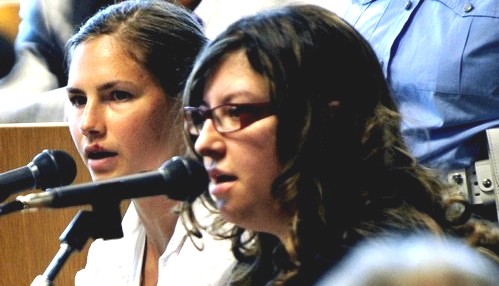
In the book though, it is all different.
In the book, the police having told her that the text is to someone called Patrick, Knox is a model of co-operation as, having already told them that he is her boss at Le Chic, she then gives a description of him and answers their questions as to whether he knew Meredith, whether he liked her etc. No reluctance to co-operate, no memory difficulties here.
Notwithstanding this, her book says the questions and insinuations keep raining down on her. The police insist that she had left Sollecito’s to meet up with - and again the police name him - Patrick.
“Who did you meet up with? Who are you protecting? Why are you lying? Who’s this person? Who’s Patrick?”
Remember again, according to her trial testimony the police did not mention Patrick’s name and Knox still hasn’t mentioned his name. But wait, she does in the next line -
“I said “Patrick is my boss.””
So now, at any rate, the police have a positive ID from Knox regarding the text message and something to work with. Patrick - boss - Le Chic.
Knox then refers to the differing interpretations as to what “See you later” meant and denies that she had ever met up with Patrick that evening. She recalls the interpreter suggesting that she was traumatized and suffering from amnesia.
The police continue to try to draw an admission from Knox that she had met up with Patrick that evening - which again she repeatedly denies. And why shouldn’t she? After all, she denies that she’s suffering from amnesia, or that there is a problem with her memory. The only problem is that Sollecito had said she had gone out but that does not mean she had met with Patrick.
Knox then writes, oddly, as it is completely out of sequence considering the above -
“They pushed my cell phone, with the message to Patrick, in my face and screamed,
“You’re lying. You sent a message to Patrick. Who’s Patrick?”
That’s when Ficarra slapped me on my head.”
A couple of blows (more like cuffs) to the head (denied by the police) is mentioned in her trial testimony but more likely, if this incident ever happened, it would have been earlier when she was struggling to remember the text and to whom it had been sent. Indeed that’s clear from the context of the above quotes.
And this, from her trial testimony -
Remember, remember, remember, and then there was this person behind me who—it’s not that she actually really physically hurt me, but she frightened me.”
In the CNN TV interview with Chris Cuomo, Knox was asked if there was anything she regretted.
Knox replied that she regretted the way this interrogation had gone, that she wished she had been aware of her rights and had stood up to the police questioning better.
Well actually, according to the account in her book, she appears to have stood up to the police questioning with a marked degree of resilience and self- certainty, and with no amnesia. There is little of her trademark “being confused”.
So why the sudden collapse? And it was a sudden collapse.
Given the trial and book accounts Knox would have us think that she was frightened, that it was due to exhaustion and the persistent and bullying tone of the questioning, mixed with threats that she would spend time in prison for failing to co-operate. She also states that -
(a) she was having a bad period and was not being allowed to attend to this, and
(b) the police told her that they had “hard evidence” that she was involved in the murder.
Knox has given us a number of accounts as to what was actually happening when this occurred.
In a letter she wrote on the 9th November she says that suddenly all the police officers left the room but one, who told her she was in serious trouble and that she should name the murderer. At this point Knox says that she asked to see the texted message again and then an image of Patrick came to mind. All she could think about was Patrick and so she named him (as the murderer).
During a recorded meeting with her mother in Capanne Prison on the 10th November she relates essentially the same story.
In her book there is sort of the same story but significantly without mention of the other officers having left the room nor mention of her having asked to see the texted message again.
If the first two accounts are correct then at least the sense of oppression from the room being crowded and questions being fired at her had lifted.
Then this is from her book -
In that instant, I snapped. I truly thought I remembered having met somebody. I didn’t understand what was happening to me. I didn’t understand that I was about to implicate the wrong person. I didn’t understand what was at stake. I didn’t think I was making it up. My mind put together incoherent images. The image that came to me was Patrick’s face. I gasped. I said his name. “Patrick””it’s Patrick.
It’s her account, of course, but this “Patrick - It’s Patrick” makes no sense at this stage of it unless it’s an admission not just that she had met up with Patrick but that he was at the cottage and involved in Meredith’s death.
And this is from her trial testimony -
GCM : Now what happened next? You, confronted with the message, gave the name of Patrick. What did you say?
AK : Well, first I started to cry. And all the policemen, together, started saying to me, you have to tell us why, what happened? They wanted all these details that I couldn’t tell them, because in the end, what happened was this: when I said the name of Patrick I suddenly started imagining a kind of scene, but always using this idea: images that didn’t agree, that maybe could give some kind of explanation of the situation.
There is a clear difference between these two quotes.
The one from her book suggests that she was trying hard but that the police had virtually brought her to the verge of a mental breakdown.
Her trial testimony says something else; that a scene and an idea was forming in her mind brought on by her naming of Patrick.
In her book she states that a statement, typed up in Italian, was shoved under her nose and she was told to sign it. The statement was timed at 1.45 am. The statement was not long but would probably have taken about twenty minutes to prepare and type.
The statement according to Knox -
... I met Patrick immediately at the basketball court in Piazza Grimana and we went to the house together. I do not remember if Meredith was there or came shortly afterward. I have a hard time remembering those moments but Patrick had sex with Meredith, with whom he was infatuated, but I cannot remember clearly whether he threatened Meredith first. I remember confusedly that he killed her.
The fact that the statement was in Italian is not important. Knox could read Italian perfectly well. However she does insinuate in the book that the details in the statement were suggested to her and that she didn’t bother to read the statement before signing.
Apart from what has been mentioned above, there are some other points and inferences to be drawn from the above analysis.
- 1. Knox’s account destroys one of Sollecito’s main tenets in his book Honour Bound. Sollecito maintains that he did nothing to damage Knox’s alibi until he signed a statement, forced on him at 3:30 am and containing the damaging admission that Knox had gone out. But Knox makes it clear that she had heard from the Head of the Murder Squad that he had made that damaging admission, at or shortly after 12.30 am. Or is Knox is accusing Napoleoni of a bare-faced lie?
2. It is valid to ask why Knox would not want to remember to whom the text had been sent. Who can see into her mind? Perhaps Knox realized that discussion of it would confirm that if she had indeed gone out then it was not to Le Chic, where she was not required. However even if she thought that could put her in the frame it’s not what an innocent person would be too worried about. Perhaps she did just have difficulty remembering?
3. If there was no fuss and she did remember and tell the police that the text was to Patrick, and the questioning then moved on to whether she met up with Patrick later that evening, what was the problem with that? She knew the fact that she hadn’t met up with him could be verified by Patrick. She could have said that and stuck to it. The next move for the police would have been to question Patrick. They would not have had grounds to arrest him.
4. Knox stated in her memorial, and re-iterates it in her book, that during her interrogation the police told her that they had hard evidence that she was involved in Meredith’s murder. She does not expand on what this evidence is, perhaps because the police did not actually tell her. However, wasn’t she the least bit curious, particularly if she was innocent? What was she thinking it might be?
5. I can sympathise with any interviewee suffering a bad period, if that’s true. However the really testy period of the interview/interrogation starts with the arrival of the interpreter, notification of Sollecito’s withdrawal of her alibi and the questioning with regard to the text to Patrick, all occurring at around 12.30 am. There has to be some critical point when she concedes, whether to the police or in her own mind, that she’d met “Patrick”, after which there was the questioning as to what had happened next. Say that additional questioning took 20 minutes. Then there would be a break whilst the statement is prepared and typed up. So the difficult period for Knox, from about 12.30 am to that critical point, looks more like about 35 to, at the outside, 50 minutes.
6. Even if, for that period, it is true that she was subjected to repeated and bullying questions, and threats, then she held up remarkably well as I have noted from her own account. It does not explain any form of mental breakdown, let alone implicating Patrick in murder. In particular, if Knox’s letter of the 9th and the recording of her meeting with her mother on the 10th are to believed, that alleged barrage of questions had stopped when she implicated Patrick. An explanation, for what it’s worth, might be that she had simply ceased to care any longer despite the consequences. But why?
7. A better and more credible explanation is that an idea had indeed formed suddenly in her mind. She would use the revelation about the text to Patrick and the consequent police line of questioning to bring the questioning to an end and divert suspicion from her true involvement in the murder of Meredith Kercher. She envisaged that she would be seen by the police as a helpless witness/victim, not a suspect in a murder investigation. As indeed was the case initially. She expected, I am sure, to be released, so that she could get Sollecito’s story straight once again. If that had happened there would of course remain the problem of her having involved Patrick, but I dare say she thought that she could simply smooth that over - that it would not be a big deal once he had confirmed that there had been no meeting and that he had not been at the cottage, as the evidence was bound to confirm.
At the beginning I said that we also have a transcript now of the evidence of the interpreter, Anna Donnino. I will summarise the main points from her evidence but it will be apparent immediately that she contradicts much of what Knox and her supporters claim to have happened.
Donnino told the court that she had 22 years experience working as a translator for the police in Perugia. She was at home when she received a call from the police that her services were required and she arrived at the police station at just before 12.30 am, just as Knox said. She found Knox with Inspector Ficarra. There was also another police officer there whose first name was Ivano. At some stage Ficarra left the room and then returned and there was also another officer by the name of Zugarina who came in. Donnino remained with Knox at all times
The following points emerge from her testimony :-
- 1. Three police officers do not amount to the “lots of people” referred to in Knox’s trial testimony, let alone the dozens and the “tag teams” of which her supporters speak.
2. She makes no mention of Napoleoni and denied that anyone had entered the room to state that Sollecito had broken Knox’s alibi. (This is not to exclude that this may have happened before Donnino arrived)
3. She states that Knox was perfectly calm but there came a point when Knox was being asked how come she had not gone to work that she was shown her own text message (to Patrick). Knox had an emotional shock, put her hands to her ears and started rolling her head and saying “It’s him! It’s him! It’s him!”
4. She denied that Knox had been maltreated or that she had been hit at all or called a liar.
5. She stated that the officer called Ivano had been particularly comforting to Knox, holding her hand occasionally.
6. She stated that prior to the 1.45 am statement being presented to Knox she was asked if she wanted a lawyer but Knox said no.
7. She stated that she had read the statement over to Knox in english and Knox herself had checked the italian original having asked for clarification of specific wording.
7. She confirmed that that she had told Knox about an accident which she’d had (a leg fracture) and that she had suffered amnesia about the accident itself. She had thought Knox was suffering something similar. She had also spoken to Knox about her own daughters because she thought it was necessary to establish a rapport and trust between the two of them.
The account in Knox’s book is in some ways quite compelling but only if it is not compared against her trial testimony, let alone the Interpreter’s testimony: that is, up to the point when she implicates Patrick in murder. At that point no amount of whitewash works. The Italian Supreme Court also thought so, upholding Knox’s calunnia conviction, with the addition of aggravating circumstances.
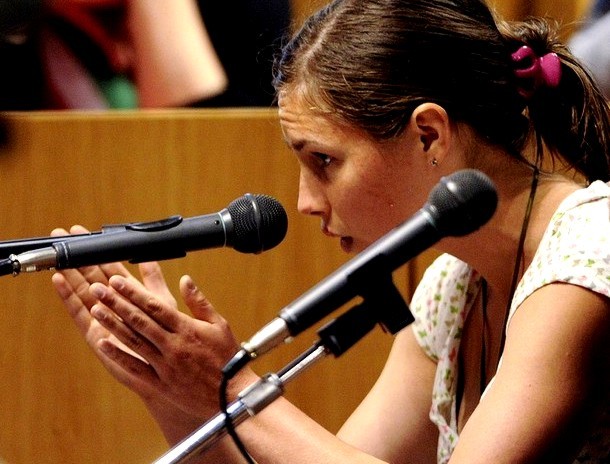
Wednesday, November 27, 2013
Amanda Knox Lies Again To Get Herself Into Another European Court “But Really, Judge, Its Only PR”
Posted by Kermit
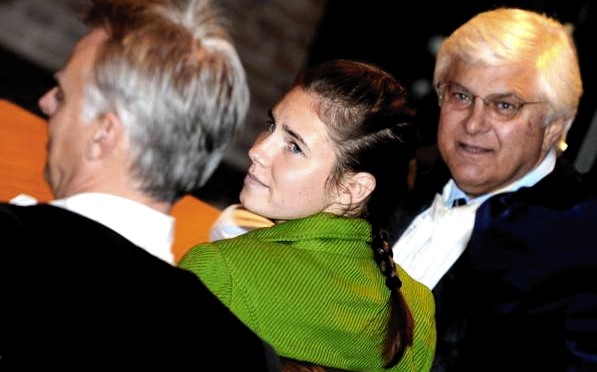
[Amanda Knox’s lawyer Luciano Ghirga (right): “Amanda wasn’t hit, we made no complaint”]
Introduction
This is the first of two posts on Knox’s claim to have sent an appeal to the Strasbourg-based European Court of Human Rights (ECHR).
Last Monday the main event that followers of the Meredith Kercher murder case were awaiting was the closing argument by Prosecutor Alessandro Crini in Amanda Knox’s and Raffaele Sollecito’s appeal trial.
Dr Crini’s structuring of the prosecution’s case in 16 points demolished the defendants’ efforts to present the volume of evidence against them as an incredible, long series of mistakes, coincidences and misunderstandings.
It seems, however, that Amanda Knox and her people didn’t want the public to be too fascinated by Dr Crini’s devastating argument. They really wanted them to be distracted by what can only be seen as an ill-judged public relations move, breaking yet more laws along the way.
Knox attempted to blow smoke over the prosecution’s arguments by grandly announcing “today, my lawyers filed an appeal of my slander[sic] conviction with the European Court of Human Rights.” That explanation of her PR ploy calls for a close review of her eligibility (here) and her so-called proof (next post).
Knox’s eligibility or otherwise
The European Court of Human Rights, is a supranational European tribunal dedicated to ““ as its name suggests - human rights.
It is not dedicated to criminal or civil proceedings on murder, sexual assault, theft, simulation of a crime, or any of the other charges that Knox faces.
In fact, to avoid the many unnecessary or spurious applications which hamper real cases getting attended to, the ECHR provides a number of online resources on who may apply and how and why.
One of the first issues that its advice underlines is that it is not a glorified appeals court:
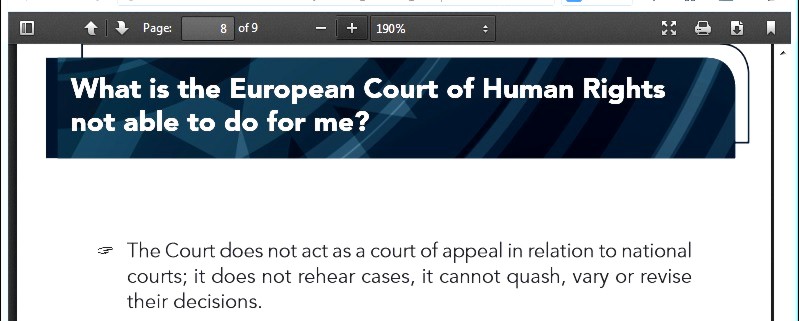
It is strange then, that Amanda Knox claims that her lawyers have “appealed” her case to the ECHR.
Either Knox’s legal advisors are just ignorant (which ones? The Italian professionals, or the American media hacks?) or this is simply a last-ditch Hail Mary action as an extradition request moves inexorably closer.
If the ECHR makes clear that it isn’t a court of appeal, there shouldn’t be any direct correlation between the Supreme Court confirming her as a convicted criminal and her application to the ECHR.
If that is in fact the basis of their application, it will not go far before rejection. In fact, the vast majority (more than 95%) of applications get rejected:
“For a number of years now, and owing to a variety of factors, the Court has been submerged by individual applications (over 130,000 were pending as at 31 August 2010). The overwhelming majority of these applications (more than 95%) are, however, rejected without being examined on the merits for failure to satisfy one of the admissibility criteria laid down by the Convention.
This situation is frustrating on two counts.
Firstly, as the Court is required to respond to each application, it is prevented from dealing within reasonable time-limits with those cases which warrant examination on the merits, without the public deriving any real benefit.
Secondly, tens of thousands of applicants inevitably have their claims rejected, often after years of waiting.”
It would be a outrageous if other, real human rights cases were delayed due to a Public Relations ruse as part of an extra-judicial strategy to undermine a request for Knox’s extradition.
Other ECHR on-line resources help potential applicants decide if they be eligible to be heard at the Court.
Below, a work-flow chart presents the main steps, including various “Admissibility Criteria”:
A first admissibility criterion
The first Admissibility criterion is that an applicant has exhausted “domestic remedies” in pursuing the recognition and correction of the human rights he or she feels have been abused.
Knox in her application to the ECHR directly relates the Italian Supreme Court final confirmation of her “calunnia” sentence (three years for obstruction of justice for framing her kindly boss Patrick Lumumba as the murderer of Meredith Kercher, thereby throwing off the course of the investigation) to her application to the ECHR.
But what were the supposed human rights abuses suffered? What did she do to remedy them?
The first requirement of exhausting “domestic remedies” means that the rights abuses that Knox alleges she has suffered have been pursued in Italy, and that all possible instances of reclamation in Italy have been visited.
However, as far as the public knows, Knox has not even placed a formal complaint concerning supposed civil rights abuse. Certainly her own Italian lawyers have said they havent.
The US and Italian publics would be interested in seeing her specific claims to the ECHR and whether there is any registration of such claims or complaints with the Italian police or other administrative or NGO offices.
Knox’s needling stepfather, Chris Mellas, stated in April 2008 on a precursor to the PMF discussion forum that a complaint had been filed concerning Amanda being hit during questioning.
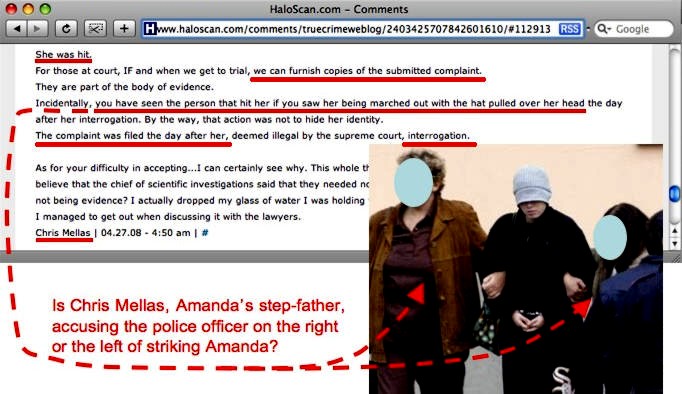
[Click for larger version]
However, nothing more has ever been heard of this complaint, which definitely would have been a starting point for pursuing domestic Italian remedies to the claimed rights abuse.
Since it appears zero rights abuses have been pursued in Italy, and the date of Knox’s application to the ECHR is in effect unrelated to her “calunnia” sentence confirmed by the Supreme Court, the six month limit beyond national remedies related to the rights abuse for applying to the ECHR is irrelevant here.
It should be noted that when Prosecutor Crini asked this week for an addition to Knox’s confirmed sentence for “calunnia”, adding another year to the three years already served by the convicted criminal, this is not a reopening of the “calunnia” case or an example of “double jeopardy”, but rather the reassessment on appeal of a separate, pending issue related to the basic calunnia charge: whether it should include an additional year of sentence for being aggravated.
Since this aggravation addition to the charge is awaiting determination, and follows from instructions of the Italian Supreme Court (and could result in an additional year in prison), it is not part of the prior, confirmed sentence.
A second admissibility criterion
Now just in case Knox or her lawyers would like to allege any perceived human rights abuse whatsoever in their ECHR application, the Strasbourg court insists on the reclamation in question being directly related to one of the sections of the European Convention on Human Rights
I’ve gone through it and I see chapters related to illegal detention (detention permitted only following arrest) and torture, but nothing related to getting cuffed on the back of your head.
If such an event ever occurred, it shouldn’t have, but quite likely one of the other authorities or rights bodies listed by the ECHR may be better equipped to deal with it.
This is a second Admissibility Criterion that filters out many applications: one can’t simply run to the ECHR saying “my rights have been abused” ““ the issue at hand must be directly related to the European Convention on Human Rights.
I seriously doubt the “hitting” event ever occurred because Knox’s own Italian lawyer Luciano Ghirga denied it, stating to the Press on 21 October 2008:
Amanda wasn’t hit. There were pressures fom the police, sure, but we never said she was hit.
As our next post here on this same subject will show, even Knox herself admitted she was treated well.
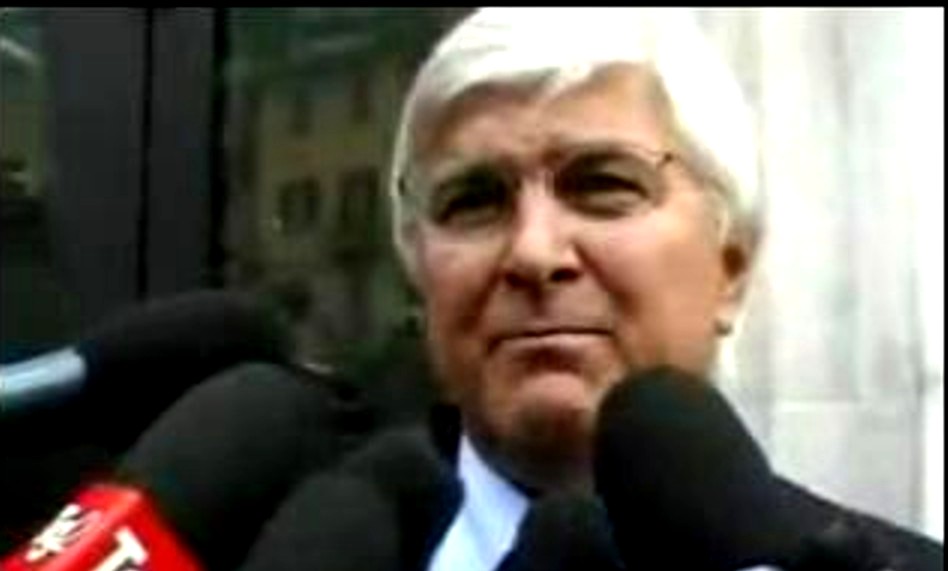
[Above: Amanda Knox’s Italian courtroom lawyer stating to the Press in 2008 that she had not been hit.]
If Knox hasn’t even tried to remedy being allegedly hit in Italy by suing or making formal complaints, nevertheless the Italian police certainly have acted upon such suggestions.
A number of legal processes are under way against Knox and her family members for slander and calunnia. Knox might face two more charges of aggravated calunnia. Why do I doubt that Knox has even mentioned those other legal processes in her application to the ECHR?
Those charges would of course have to be taken care of (as part of “exhausting domestic remedies”) before the ECHR would be able to consider her application, assuming it surmounted all of its other shortcomings to get to the ECHR judges’ hands.
A third admissibility criterion
Another Admissibility Criteria is the “Significant Disadvantage” filter. If an alleged rights abuse is minimal ““ compared to the very serious issues that the ECHR was created to consider ““ the application will go no further.
The only violent description of Knox’s alleged beating was given by her stepfather, Chris Mellas: “She was interrogated, and hit, and threatened,” he typed. “Tortured. Physically and mentally”.
However, there was never any medical or forensic notification of such “torture” before or after her incarceration in Capanne Prison.
Rather, Knox spent her time in prison receiving regular visits from a lovelorn Italian politician who befriended her, and participating in prison musical and theatrical activities.
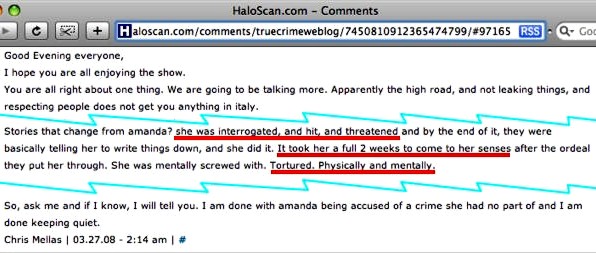
[Click for larger version]
In underlying the “significant disadvantage” requirement, the ECHR states in its examples of rejected claims, that it can’t be distracted by the French driver who lost a point on his driver’s licence, or the Romanian who claims 90 euros from the State, when the Court has real and serious Human Rights cases to deal with such as:
- El-Masri v. the former Yugoslav Republic of Macedonia (Article 3 of European Convention on Human Rights: Torture and inhuman and degrading treatment during and following applicant’s extraordinary rendition to CIA)
- Hirsii Jamaa and others v. Italy (Article 4 of Protocol No. 4: Return of migrants intercepted on the high seas to country of departure)
It’s almost certain that Knox has not pursued on an Italian level any remedies to her alleged human rights abuse (whatever it was), nor is there any evidence that the investigation into Meredith Kercher’s murder and the subsequent trials of Knox, Rudy Guede and Raffaele Sollecito were affected in their outcome by the rights abuse.
This is especially the case if the limit of Knox’s human rights suffering is that described by a talky ex-FBI helicopter pilot turned ex-college security guy turned Amanda Knox groupie, Steve Moore.
Moore describes the “frightful” circumstances of Knox’s witness questioning on the night of 5 November 2007 for the couple of hours (perhaps even somewhat less) that it lasted:
No food, no coffee, no bathroom breaks ““ nothing.
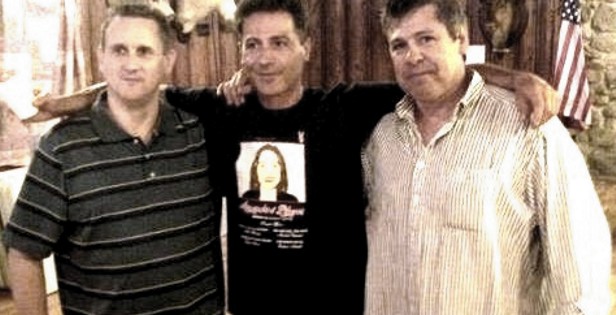
Above is ex-college security man Steve Moore, right, together with PR flunkie Bruce Fischer, left, both flanking “Frank Sfarzo”, a Knox-Mellas family friend.
Francesco Sforza is currently a fugitive from the Seattle courts on two counts of Assault-Domestic Violence, who continues to support Amanda in ongoing Internet blog posts, from wherever he may be.
See below. Click for larger. In purple, my corrections to Knox’s “what-I-want-the-World-to-believe” post about applying to the ECHR.
In conclusion
Between the manifest doubtfulness of the acceptability of Knox’s application to the European Court of Human Rights, on one hand, and the falsehoods and half-truths in her announcement, on the other, why do I get the feeling that the only reason and hope she and her team have in announcing the application (whether really filed or not) is to distract the attention of the followers of her appeal trial from the prosecution’s weighty arguments?
This will have little if any effect on the wheels of Italian Justice, and probably even less on a State Department more concerned with maintaining good relations with European allies while diplomatic challenges occur in the Middle East and Asia, than with a lobby plan to prevent Knox’s extradition.
[Below: The European Court of Human Rights in Strasbourg France]
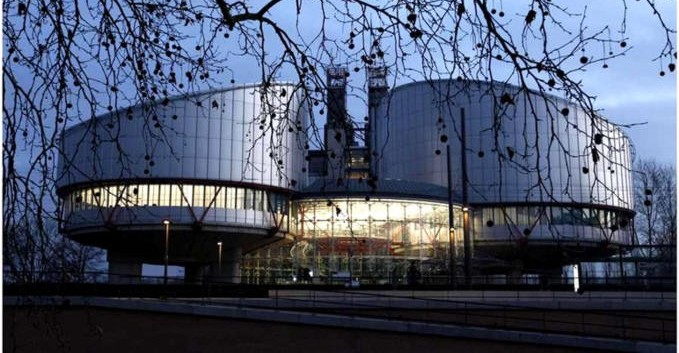
Sunday, November 10, 2013
The Crime-Scene Clean-Up: How Rudy Guede’s Diary Provides Even More Proof That It Happened
Posted by pat az
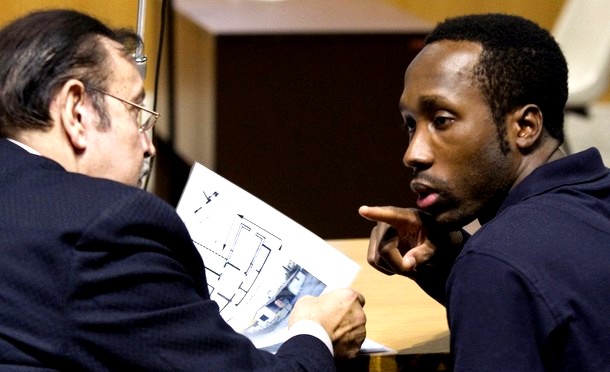
This post is crossposted from my own place. Here is one of my previous crime scene analyses on TJMK.
Rudy Guede was ultimately declared convicted by the Supreme Court in 2010 of participating in the 2007 murder of Meredith Kercher.
The prosecution claims the two other participants are Amanda Knox and Raffaele Sollecito. Knox and Sollecito are currently appealing their conviction of the same crime.
The case against the three of them involves a suspected clean up of the hallway in the apartment after the crime. Meredith’s blood was found in the bathroom, and half a footprint in her blood was found on the bathroom mat. However, there was no visible blood between Meredith’s bedroom and the bathroom.
The only visible blood in the hallway were faint partial shoe prints that led directly out the front door of the apartment.
After the murder was discovered, the media reported almost daily on developments in the case. The day of the murder, the press reported on the blood found in the bathroom and the bedroom.
But until police used luminol at the apartment on December 18th, the media didn’t report on any significant blood found in the hallway. Between November 2nd and December 18th, only one person stated that significant amounts of blood had been in the hallway.
Rudy Guede.
Rudy Guede actually wrote about it in his diary between Nov 20th and Dec 6th, after being captured in Germany.

The police arrived at the apartment on November 2nd. According to media reports, the blood they spotted immediately was only in the bathroom and Meredith’s bedroom. When the scene was more closely examined, after the discovery of the body, police found visible blood patterns on the floor left by Guede’s left shoe as he left the apartment.
None of the people who arrived in the apartment on the afternoon of November 2nd reported seeing them; these footprints are not in any of the stories of the events of Nov 2nd told by Amanda Knox nor Raffaele Sollecito. So, while these prints were visible, they were not substantially obvious.
On December 18th 2007 investigators applied Luminol in the hallway and other bedrooms. This forensic chemical is used to detect blood which has been cleaned away. The Luminol revealed several footprints in the hallway between the bedrooms of Knox and Meredith. Example below. Some of these footprints were leading towards Meredith’s door.
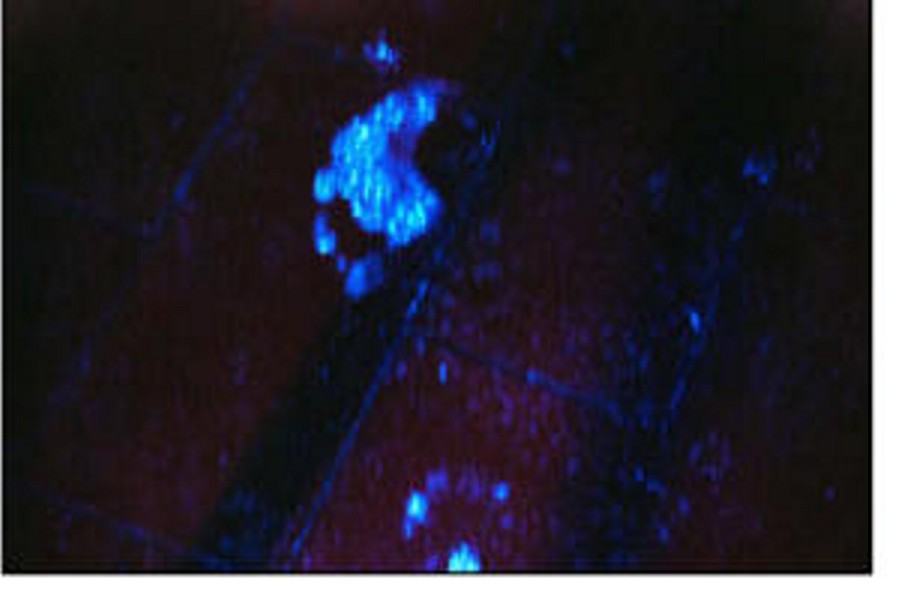
They also discovered prints in Filomena’s room which contained Meredith’s DNA and Amanda Knox’s DNA. They also revealed a footprint in Amanda Knox’s bedroom. (The defense unsuccessfully contested the investigator’s conclusions that these prints were made with blood).
On November 19 2007, an international arrest warrant was issued for Rudy Guede. He was arrested in Germany on November 20th. Guede remained in Germany until his extradition on December 3rd.
During his stay in jail in Germany, Guede wrote a long statement that was published and translated. Guede’s writings are similar to to Knox’s jail writings in many ways - they both try to write out their own detailed version of events, while pointing blame elsewhere.
But Guede’s comments may in fact be confirmation of a clean-up after the murder of Meredith Kercher (emphasis added):
I am asking myself how is it possible that Amanda could have slept in all that mess, and took a shower with all that blood in the bathroom and corridor? (Guede, Germany Diary, P21)
The police did not find evidence of any other blood until December 18th, AFTER Guede returned from Germany. As indicated above, the luminol revealed multiple footprints in the hallway, in Knox’s bedroom, and in Filomena’s bedroom. The image below shows these results in blue. Guede’s partial footprints are shown in red.
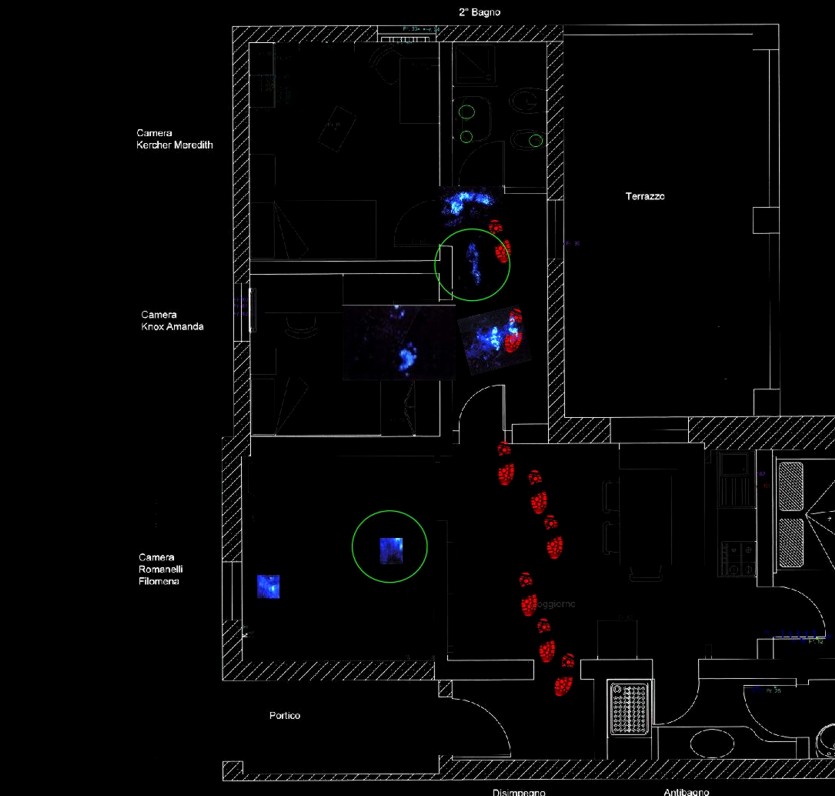
The conclusion is inescapable: Guede knew there would be significant evidence of blood in the hallway, before the police themselves found that evidence.
How did Guede know there would be more blood found in the hallway, before the police found that evidence on December 18th? And why wasn’t that blood there on the morning of November 2nd?
The courts believe the blood in the hallway was cleaned after the murder of Meredith Kercher. And the Micheli and Massei courts believed only one person had the motivation to hide this evidence: Amanda Knox.
Here is a summary of Judge Micheli’s October 2008 indictment finding.
In Judge Massei’s December 2009 trial finding for the original conviction of Knox and Sollecito, he also writes about the clean-up that the judges believed to have happened:
Further confirmation is constituted by the fact that, after Meredith’s murder, it is clear that some traces were definitely eliminated, a cleaning activity was certainly carried out. In fact, the bare foot which, stained with blood, left its footprint on the sky-blue mat in the bathroom, could only have reached that mat by taking steps which should have left other footprints on the floor, also marked out in blood just like (in fact, most likely, with even more [blood], since they were created before the footprint printed on the mat) the one found on the mat itself. Of such other very visible footprints of a bloody bare foot, on the contrary, there is no trace. (Massei, Dec 09; PMF translation)
In defense of Guede, Knox, and Sollecito, some might try to claim that Guede heard about blood in the hallway in the news. Rudy Guede was arrested 18 days following the murder of Meredith Kercher. During that time he had access to read the news and watch reports.
I have searched for articles in the period between November 2nd and December 18 which mention blood. All of the articles I have found so far discuss blood in the bedroom or the bathroom. One or two discuss footprints leading to the front door.
None of them discuss blood in the hallway that would justify a statement from Guede of “tutto quel sangue nel bagno e sul corridoghe” (all that blood in the bathroom and in the corridor)
Guede himself said he went between the bedroom and the bathroom, so may have tracked blood into the bathroom and therefore known blood would be found in the hallway.
Even that knowledge however confirms a clean-up, as there was not a trail of blood between the bathroom and Meredith’s room that justifies the footprint on the bathmat and blood found in the bathroom.
I have my own questions as a result of Guede’s knowledge of blood in the hallway:
Could the attack have started in the hallway? Could the first blood shed have been on the hallway tiles?
The prosecution and courts argue that Amanda Knox had a role in the attack and murder. Knox and her supporters are very adamant that there is no trace of Knox in Meredith’s bedroom. While the courts argue otherwise, could Knox’s role have been limited to the hallway?
Sadly, we may never know the full truth of what happened on the evening of November 1st, 2007.
My timeline of media reports on blood
- Nov 2nd: Meredith Kercher found. Blood found in bathroom.
- Nov 5th: Police analyzing traces of blood from apartment below.
- Nov 5th: A “trail of blood” is on the inside handle of the door to the apartment.
- Nov 7th: reports of Amanda Knox’s statements, includes finding blood in the bathroom.
- Nov 14th: Police use of Luminol at Sollectio’s house. First reports on the knife seized by police from Sollecito’s house.
- Nov 19th: Analysis of blood in bedroom (pillow, bra, etc).
- Nov 22nd: Guede’s prints in blood.
- Nov 27th: Amanda Knox’s blood on bathroom tap.
- Nov 28th: Blood in bathroom.
- Dec 5th: Reports of Guede’s letter to father: “there was so much blood”.
My timeline of main events involving Guede
- Nov 2nd, 2am ““ 4:30 am: Guede seen by witnesses at Domus nightclub.
- Nov 3: Guede leaves Perugia for Germany
- Nov 11: Guede’s cell phone tracked in Milan (Corriere)
- Nov 12: Newspaper reports a 4th suspect.
- Nov 19: Guede identified as suspect in newspapers
- Nov 19: Guede skype conversation with friend.
- Nov 20: Patrick released from prison.
- Nov 20: Guede arrested while trying to return to italy on train in Germany.
- Nov 21: Guede interrogated by German police; Guede admits to being at apartment, blames an italian man for murder.
- Nov 20-Dec 5: Guede writes diary in German prison.
- Dec 3: Germany grants Guede’s extradition back to Italy.
- Dec 6: Guede returns to Perugia.
- Dec 7: Guede interrogated by Magistrate.
- Dec 14: Guede ordered to remain in prison.
- Dec 17: Knox is questioned by Mignini.
- Dec 18: Police use luminol in apartment and find footprints in hallway and in Filomena’s bedroom.
Tuesday, November 05, 2013
RS And AK Seemingly Competing To “Appropriate” Meredith: Ghoulish, Sadistic And Very Cruel? Or…?
Posted by Our Main Posters
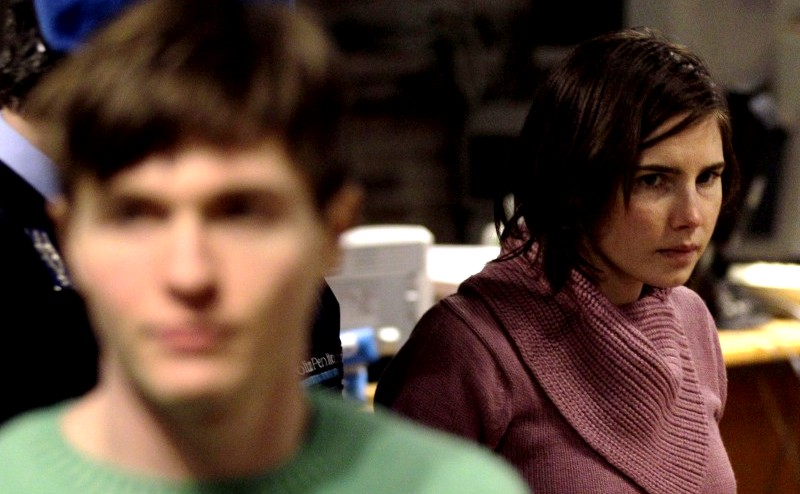
Amanda Knox has stated several times on national TV that she would like to visit Meredith’s grave.
Meredith’s father responded very firmly that this was quite out of the question. The family will never approve. Perhaps predictably, Raffaele Sollecito then announced triumphally that he had already been.
We can be sure that this exchange will do them no good at all in the Florence court, where the prospects of Judge Massei’s special considerations (which lopped five years off their sentences) being re-allowed by the Nencini court now seem pretty dim.
Other than as a ghoulish competition, can this be seen any other way? Last Saturday, Skeptical Bystander, no great lover of the perps, aired the suggestion that we might be seeing a new psychological phase coming into play
Skeptical Bystander
My thinking has evolved somewhat about the report that RS visited Meredith’s grave, as well as about AK’s non-stop chatter about doing so with the Kerchers and her grotesque appropriation of Meredith.
I just caught part of a documentary treatment of the Menendez case, wherein two brothers, Lyle and Eric, killed their parents. Both were sentenced to life in prison. In a probation report, Lyle is quoted as saying he has found peace by visiting his parents’ grave, asking for forgiveness, and understanding that they have forgiven him.
It is entirely possible that both AK and RS want forgiveness from Meredith and from her family. What they don’t seem to realize is that they can’t take shortcuts or be given a free pass. Lyle Menendez got sentenced for his crime and began the process of self-examination that leads to accountability.
We asked two of our posting psychologists if we could indeed be seeing something like this. With their agreement, this is their email exchange, in which they both concede that Skeptical Bystander may have had a point:
Psychologist A:
It is entirely probable they want, indeed crave, ‘forgiveness’. The problem is that dysfunctional or disturbed personalities may be able to be aware of their guilt, but not of their shame.
The guilt would want the forgiveness, but the process that leads to the resolution that is forgiveness will not occur - indeed I believe cannot occur- until the shame is ‘owned’.
Just judging from Raffaele’s and Amanda’s faces alone, I would estimate that Raff is slightly nearer than Amanda in approaching his own shame. Unfortunately I see zero in Amanda, and therein lies the huge problem.
If someone lacks sincerity, someone else or circumstances cannot make them more sincere - what I call authentic. It has to come from self-realization.
That’s my ‘take’!
Psychotherapist B:
At a certain point, this is all just speculation about someone I’ve never met, so it’s hard to say one way or another.
My best guess would be that in this case neither Knox nor Sollecito has shown any public signs of really being able to admit to themselves that they’ve done anything to be sorry for.
For what it’s worth, my overall impression, based on what’s been made public, is that Knox would likely not ever have killed anyone if she hadn’t been high and in an especially reckless period of her life and influenced by meeting Sollecito.
She might have gone on being somewhat impulsive and aggressive without ever actually harming anyone, and with luck she might have outgrown it in a few years. I think the kind of cruelty we’ve seen in this case is driven by unconscious feelings and motives.
Clearly it pains her to be seen as guilty; the idea that anyone can think that about her bothers her a lot. It’s easier for me to picture her wanting a visit to Meredith Kercher’s grave to somehow clear her of all of this upsetting suspicion, than truly wanting Meredith’s forgiveness - more wanting to get rid of shame than to atone for guilt or repair harm, if that makes sense.
When I think of forgiveness, I think of a more mature kind of experience. It takes maturity and integrity to own that you’ve done something harmful, to withstand whatever feelings of shame and guilt the realization brings, and to seek to make actual reparation.
But anyone can feel haunted by having done a bad thing, and want someone to take the haunting away. I’m reminded of Bill in Oliver Twist - after he kills Nancy he feels sorry for himself and overwhelmed by the fear of retribution, but you couldn’t say he’s exactly seeking forgiveness - well, maybe a two-dimensional version of it.
Psychologist A:
Yes, quite right. It is all dreadfully disheartening, and still shockingly cruel.
I agree deeply about the unconsciousness of what is going on. One would expect immature adolescents to be acting a lot from their unconscious, and one of the troubles with the joint denial of events is that they are preventing themselves (and others) from growing or becoming more conscious, but instead ‘freezing’ themselves at that awful time 6 years ago.
You: “He feels sorry for himself and overwhelmed with the fear of retribution, but you couldn’t say he’s exactly seeking forgiveness—well, maybe a two-dimensional version of it. “
I see true forgiveness as a powerful phenomenon which occurs at a crucial stage of a healing process. I think it is something that occurs, that happens to one, is experienced, and is far greater than anyone’s ego.
I would think that someone who had hardly begun, or who had not at all commenced, upon this process would actually have no idea about what forgiveness might actually look or feel like, or be, in fact - let alone how to arrive at it.
Their consequent confusion might then manifest in ,as you say, wanting a two-dimensional version of it, that could be summed up as merely ‘not wanting to be seen as bad’. So perpetuating the ‘good image(s)’ of themselves, which is a gross evasion.
They certainly want not to be hated, as probably anyone does. But it is a huge chasm to actually doing something about that, and learning to behave in a way that people with conscience find acceptable.
Psychotherapist B:
I think you’re absolutely right about forgiveness - thank you for saying it so well.
Sunday, November 03, 2013
Knox Apologists Attempt To Bend Congress; But Nobody Important Turns Up
Posted by Our Main Posters
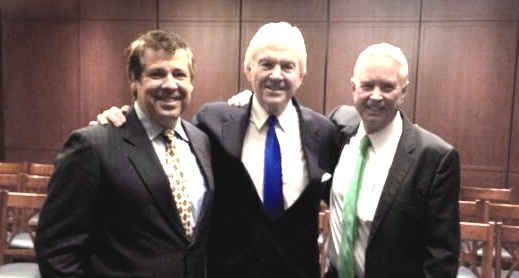
From the left: Steve Moore, John Douglas, and Michael Heavey.
In a room for hire at the Congress they made presentations of their misleading takes on the case to a near-empty room.
Senator Cantwell was apparently there briefly but took off as soon as she could. No other elected leaders were seen to be there.
There was seemingly no media coverage except for a sole post by another Knox apologist on the Infamous Ground Report.
These are hardly the most impartial or for that matter truthful and accurate observers of the case.
Click through for our numerous takedowns of the hapless Steve Moore, and John Douglas, and Michael Heavey.
Sunday, October 20, 2013
Given The Abundant Facts, What Scenario Is The Nencini Court Considering? Probably Not Unlike This
Posted by Marcello

1. The “Innocence/Framing” Campaign
It is rather sad that this case, of the violent murder of Meredith Kercher, has seen a ‘hurricane’ of noise trying to cherry-pick and disprove the more salient facts, and worse, discredit those who investigated, prosecuted and ruled on the case as well as discredit those who continue to emphasize the facts.
Over the past six years there has been a concerted effort by the defendants in this case, and primarily by their families, their “˜groupies’ and their legal consultants, to mount and continue a public relations campaign to frame the defendants as innocent of the crime of murdering Meredith Kercher. This ‘innocence’ campaign has even gone so far as to tarnish the motives of the fine justice officials involved.
The defendants themselves have continuously obfuscated and lied about the more salient facts, albeit inconsistently (their multiple versions fail to match up, and do not match the available facts). Lately Ms. Knox has done a number of (typically unconvincing) interviews, and her parents still seem too intent on defending the fantasy of their daughter’s innocence, all evidence to the contrary.
Mr. Sollecito, for his part, tweets unofficial retractions about statements he made in court. Both have distastefully profited through books that are not much more than a compilation of lies (and which do not offer matching alibis). Meanwhile the legal teams for the defendants have recently leaked “˜favorable’ results from the testing of a new sample on the presumed murder weapon in order to (again) misconstrue the evidence for the general public.
2. Media Misreporting Facilitates
Perhaps the most unfortunate aspect of this “˜innocence campaign’ has been that far too many journalists have dishonored their professional ethics by failing to do the proper research and objectively report the facts. Journalists to this day continue to misreport the facts, leave out corroborating facts, or worse, blindly repeat the distortions or lies promoted by the campaign without proper fact-checking. By and large, journalists (mostly in the US and UK) have ‘anti-reported’ the case.
This is especially grievous given that there are multiple Court Motivations reports (a unique feature to the Italian justice system) readily available in Italian and English online, in searchable PDF format, as well as several websites like this one that have painstakingly sought to illuminate the vast amount of evidentiary facts.
Those journalists who have failed to correctly report the case, and those involved in this ‘innocence’ campaign, have repeatedly disrespected the victim, Meredith Kercher, and her family. By contrast, the Kerchers has shown great dignity throughout these years, remaining patiently quiet and consistently insisting that the truth be revealed by the Italian justice system.
The endless journalistic failures, and particularly the ‘innocence’ campaign, have also disrespected the Italian law enforcement and judicial systems. By contrast Italian law enforcement has demonstrated substantial deference to the defendants, especially when compared to the law enforcement and judicial procedures of other advanced countries. In response, numerous ‘groupies’ have exhibited pathetic jingoism by repeatedly denigrating a country of 60 million people based on rather uninformed attitudes.
And it is very likely that Ms. Knox and Mr. Sollecito, rather than confess the truth, will continue to obfuscate or lie as much as they can, as well as disrespect the Italian Court and the Kerchers by not being present at the appeal. Their ‘innocence’ campaigns will likely continue to distort or ignore the facts. And worse, journalists and talking-head ‘experts’ will continue to report falsehoods and misrepresentations.
3. All Will Now Be To No Avail
Fortunately, none of the fabrications, ill-conceived scenarios or numerous pieces of unprofessional, sloppy journalism will ultimately matter.
This is because the Nencini Appeals Court will not be listening to any of the noise. The Appeals Court has a very specific program to follow, mandated by the Italian Supreme Court, which has already looked at this case four times (the detainment requests for Knox and Sollecito, the conviction of Rudy Guede and the annulment of the Hellmann Appeals Court ruling). The Nencini Appeals Court program includes:
- 1) looking at all the case evidence noted in Judge Massei Trial Court’s Motivations report,
2) considering the Italian Supreme Court’s Motivations report for the conviction of Rudy Guede, in which Guede was convicted of having a role in Ms. Kercher’s murder, but not the key role of fatally stabbing her, and that he acted in concert with others, and
3) considering Ms. Knox’s voluntary “˜gift’ statement of November 6, 2007, in which she placed herself at the scene of the crime. (This statement follows an earlier verbal and written statement released to the police during a few hours of interrogation in the early hours of November 6th.)
4. Big Surfeit Of Evidence
The amount of evidentiary facts the Nencini Appeals Court will have absorbed is substantial. Unlike the Hellmann Appeals Court, they cannot cherry-pick the facts. Per the Supreme Court, they must consider all the available evidence as a whole, logically tied together like a mosaic. Significantly, one could even leave out the knife and bra clasp entirely as evidence points because:
- 1) Ms. Kercher was murdered by more than one assailant. This is evident from the wounds she suffered, from the evidence in general and has been consistently maintained by three different trial judges and four different Supreme Court reports.
2) Guede in all his various confessions has consistently hinted and ultimately confirmed the presence of Knox and Sollecito during the crime.
3) There is no plausible scenario for the crime that involves Guede and two or more unknown assailants.
4) All the other evidence found at the crime scene points to Sollecito and Knox being present before, during and after the crime in some fashion.
5) Knox was at the scene of the crime by her own written admission.
6) The break-in was staged and, by obvious implication, only Knox and Sollecito would have any interest in staging the break-in (see my earlier post listing all the problems with the break-in scenario).
There seems no rational way that the Nencini Appeals Court can logically acquit. And Judge Nencini has not ‘pre-announced’ a non-guilty verdict like Judge Hellmann did by claiming that the defendants “˜appear to be innocent’.
The only remaining questions are what kind of dynamics will the Nencini Appeals Court assign to the participants, and what kind of reasoning will the Italian Supreme Court provide, assuming Knox or Sollecito appeal to the Supreme Court.
Having already read the Massei Motivations report and supporting documentation for weeks, this will already be a highly informed judges’ panel. What scenario are they converging on? The following scenario is based on some of the most significant evidence, and overall seems largely unshakable.
5. Scenario Accounting For The Most Points
The Night Before: Halloween
1) Guede lied about meeting Ms. Kercher on Halloween. (No such meeting was corroborated by witnesses.)
2) Guede lied about his whereabouts in the early evening of November 1, 2007. (His claims of having appointments with friends were not corroborated.)
Evening Prior To Attack
3) Around 8:00 PM on November 1st, Knox left Sollecito’s place to go to work. She received Lumumba’s (her boss) text message around 8:15 PM that she was not needed at work. She responded at 8:35 PM while presumably walking back to Sollecito’s apartment. Then she turned off her phone at 8:35 PM. She was seen at Sollecito’s apartment by 8:40PM.
4) Sollecito received a call from his dad at 8:42 PM. (According to the defendant, they discussed the broken trap in the kitchen sink and how to clean the kitchen floor, and about going to Gubbio with Knox the next day. Significant about this is that the broken trap and clean-up likely happened later. See below.)
5) Sollecito turned off his cellphone at roughly 8:45 PM. (typically, neither Knox or Sollecito turned off their cellphones for the night)
6) Ms. Kercher was last seen by her friend Sophie Purton at roughly 9:00 PM going to her cottage.
7) There was no human interaction with Sollecito’s computer after 9:10 PM.
8) Knox and Sollecito were seen at piazza Grimana, by the cottage, at roughly 9:30 to 10:00 PM, by a homeless man who “˜resided’ at piazza Grimana.
9) Ms. Kercher’s phone made three short calls between 10:00 and 10:15 PM roughly, to check voicemail, a possible attempt to call a bank, and possibly an MMS message.
10) A car broke down near the gate of the cottage at 10:30 PM.
11) Knox and Sollecito were seen at piazza Grimana, by the cottage, at roughly 11:00 PM, again by the same homeless man. He noted they went several times to the railing of the piazza to look down beyond it. (The piazza overlooks the gate of the cottage.)
12) A tow truck came at approximately 11:00 PM to tow the car. The driver of the truck noted a dark-colored car parked in front of the gate of the cottage, which he noted was slightly open. At approximately 11:15 PM the tow truck left and the family in the broken down car departed the area with other friends in a second car. (Sollecito had a dark colored Audi.) No screams were heard and no one noticed Guede, Sollecito or Knox pass through the gate.
13) Sollecito’s dad sent Sollecito an SMS at 11:15PM. The message was not received by Sollecito’s cellphone until roughly 6:00 AM following morning.
The Attack Upon Meredith
14) Knox likely let Sollecito and Guede into the cottage after 11:15 PM, after the tow truck and car had left. Guede went to use the large bathroom and failed to flush his feces. The following is an assumed sequence:
15) Ms. Kercher was restrained in her room and her screams were muffled. (There was bruising on Ms. Kercher’s nose, mouth, lips and chin, suggesting her mouth was covered by one or more persons; only one scream was ever heard from the cottage; Ms. Kercher was familiar with martial arts maneuvers and likely vigorously tried to defend herself)
16) Ms. Kercher was choked and her head likely banged against the wall. (Bruises on Ms. Kercher’s neck suggest she was choked with small hands; Ms. Kercher had bruises to her scalp.)
17) Ms. Kercher’s jeans may have been partially removed to restrain her legs and feet. (There were few bruises to Ms. Kerchers legs and feet, including no signs of ligature. This suggests her legs were immobilized in some other fashion.)
18) Guede held Ms. Kercher’s left wrist, leaving DNA traces on Ms. Kercher’s sweatshirt.
19) Guede likely held Ms. Kercher’s left thigh, brusing it, and left his DNA traces inside her.
20) Ms. Kercher’s sweatshirt was removed and two layers of shirts she had on were rolled up to her neck.
21) Guede left DNA traces on Ms. Kercher’s bra.
22) At least three different types of shoe prints were left on the floor in Ms. Kercher’s room on postcards, papers and the pillowcase. None of these matched Ms. Kercher’s shoes found in her room.
23) A witness heard a man and woman yelling from the direction of the cottage.
24) Ms. Kercher was pricked and stabbed with a small knife in the right side of her neck.
25) Ms. Kercher likely freed her right hand and sustained small cuts. She may have punched Knox in the nose or mouth.
26) Ms. Kercher likely freed her left hand and sustained small cuts. She may have grabbed Knox’s hair, while perhaps ripping off an earring from Knox. (Crime scene photos show blonde hair strands in Ms. Kercher’s left hand)
27) Ms. Kercher was able to scream at the top of her lungs. Two witnesses heard the scream. One witness believed it was around 11:30 PM when she heard it.
28) Ms. Kercher was pricked on her neck and chin with a knife. She was stabbed on the left side of her neck with a large knife. Her neck was roughly 16” off the floor, as suggested by a blood spray pattern on the wardrobe door close to where she was found.
29) A bloody shoeprint fitting Knox’s shoe size was left on the pillowcase. Shoeprints matching Guede’s shoes were also found on the pillowcase.
Right After The Attack
30) Guede may have gone to the bathroom to get two towels to staunch the blood. Guede confessed to this, though no DNA traces of his are found on the towels. Guede’s bloody shoeprints were found around Ms. Kercher’s body, and his bloody hand print was found on the pillow.
31) At this point, Knox may have gone to the small bathroom to check a wound. Knox left traces of her blood mixed with Ms. Kercher’s blood in the bidet, edge of the sink and Q-tip box in the small bathroom. Knox left an additional blood trace on the faucet.
32) Guede handled Ms. Kercher’s purse, leaving DNA traces of himself and Ms. Kercher, likely with Ms. Kercher’s blood. (Traces of Guede’s DNA was found on the zipper of the purse. Because the trace contains blood it was likely left after Ms. Kercher started bleeding.)
33) Guede left bloody shoeprints leading straight down the corridor and out of the cottage.
34) A witness heard someone running on the metal stair of the car park shortly after she heard the scream.
35) The same witness also heard running footsteps on the cottage pebble driveway at roughly the same time.
36) The boyfriend of another witness was bumped into by someone “˜with dark skin’ running up the stone stairs, though the time is unclear.
37) Another witness heard people running in the street that wraps behind the car park.
38) Sollecito likely tossed Ms. Kercher’s cellphones from his car into a nearby garden 1 km away from the cottage at around midnight.
39) Guede was seen at the Domus night club around 2 AM.
Evidence, Manipulated Or Overlooked
Likely sometime later during the night Sollecito and Knox returned to the cottage to eliminate evidence and frame Guede for the crime. In so doing:
40) Sollecito left a partial bloody footprint on the bathmat.
41) Sollecito left his DNA on Ms. Kercher’s bra clasp after removing the bra. (Given blood patterns on the bra, the bra may have been removed after Ms. Kercher had died and certainly after she had been stabbed on the left side)
42) Sollecito left one, possibly two, bloody footprints in the corridor.
43) Knox left two bloody footprints in the corridor. One of these contained her blood as well as Ms. Kercher’s blood. (Knox likely bled during or after the assault and may have stepped in her own blood)
44) Knox left a trace of her blood mixed with Ms. Kercher’s blood on the floor in Romanelli’s room.
45) Knox likely threw Romanelli’s clothes on the floor. She likely used an inordinately large rock to break the window with the outer shutters closed. She likely placed some of the broken glass on the window sill to fake a break-in. (Romanelli and the Postal Police found glass on top of Romanelli’s clothes and laptop, suggesting the room was ransacked and then the window was broken.)
46) Knox, perhaps inadvertently, left a piece of window glass in Ms. Kercher’s room.
47) Knox left a bloody footprint in her room.
48) Knox likely left her only room lamp in Ms. Kercher’s room by accident. (The lamp was found on the floor, by Ms. Kercher’s bed, and it may have been used to exam the bloodied floor around Ms. Kercher’s body to remove evidence, such as perhaps an earring and/or hair.)
49) Knox likely wiped away all her fingerprints throughout the entire house (While a number of fingerprints were found in the cottage and verified belonging to the three other flatmates, no fingerprints were found that could be matched to Knox, not in her room or elsewhere- except for one, on a glass in the kitchen.)
50) Knox and/or Sollecito repositioned Ms. Kercher’s body and covered it with the duvet. (Crime scene photos show from the streaks of blood that Ms. Kercher’s body was moved. There were masses of long hair mixed with blood on the floor, suggesting someone had yanked Ms. Kercher by her hair.)
51) They likely took Ms. Kercher’s wallet, closed her bedroom door and locked it.
Back At Sollecito’s Place
52) Sollecito and Knox returned to Sollecito’s place to clean up. They brought back the large knife and cleaned it with steel wool, and also tried to scrape away build-up/rust by the handle. (The knife was found at Sollecito’s place, with DNA traces of Knox on the handle and by the handle/blade joint, with a DNA trace of Ms. Kercher on the blade, with scratches on the blade and pockets of cleaned stainless steel by the handle.)
53) Sollecito likely disconnected the trap of his kitchen sink, perhaps to clean it. (The trap pipe was found disconnected.)
54) Sollecito and Knox likely used bleach to clean the floor of any blood. (Police observed a strong smell of bleach when entering Sollecito’s apartment.)
55) Sollecito and Knox apparently took a shower. (Knox has recounted a number of “˜ear cleaning’ and ‘shower’ stories.)
56) Sollecito likely put blood stained clothes and shoes into one or more garbage bags and drove in the night to dump them somewhere.
57) Sollecito used his computer at around 5:30 AM and turned on his cellphone at around 6AM.
Events On The Next Morning
58) Knox was seen at a nearby store at around 7:45 AM, just as the store was opening. She was noticed going to the cleaning products section, wearing clothes that were ultimately found on her bed at the cottage.
59) Knox may have traveled back and forth from the cottage with a mop and/or garbage bags. (In her different versions, both verbal and written, she talks about ‘having to fetch a mop from the cottage’.)
60) Knox turned on her cellphone around noon.
The Police At The House
61) Knox and Sollecito were discovered at the cottage by the Postal Police at around 12:30 PM.
62) Knox told the Postal Police that Ms. Kercher sometimes kept her door closed. (This was later contradicted by Romanelli, who insisted Ms. Kercher’s door be broken down.)
63) Knox called her mother in a panic at roughly 12:45 PM. Knox would later forget this phone call in her testimony and in her book.
64) Sollecito called the Carabinieri at around 12:50 PM, confirming nothing was stolen in Romanelli’s room, though he could not have possibly known this for certain.
65) When Ms. Kercher’s door was broken down, at around 1:15 PM, Sollecito and Knox were not with the group that broke the door down, and were not able to see inside the room.
66) Knox panicked when it seemed that Guede’s feces had been flushed by accident.
Later That Same Day
67) At the police station, Knox yelled out that Ms. Kercher “˜bled to death’.
68) At the police station, Knox inveighed against “˜those bastards’ after being fingerprinted, though it’s unclear whether she meant some other killers (and if so, why the plural), or the police.
One Day Later
69) On November 3, 2007, Sollecito lied to a reporter about how the discovery of Ms. Kercher’s body happened, recounting that Knox was the first to discover the body, and that he ‘saw blood everywhere’ even though he could not have seen into the room.
Two Days Later
70) On November 4, 2007, Knox emailed a narrative of the events from her point of view.
71) During the autopsy of November 4th, the prosecutor was convinced by the number and manner of the injuries on Ms. Kercher’s body that there had to be more than one assailant.
72) On November 4, 2007, Knox broke down when police showed her and the other roommates the knives in the silverware drawer at her cottage, to determine if any knives were missing. Knox had to be escorted outside to calm down.
73) Knox would later confess to her parents her concern about the knife at Sollecito’s apartment.
Three Days Later
74) On November 5, 2007, Sollecito failed to back up Knox and changed his alibi when confronted with cellphone records. He maintained Knox left his apartment from roughly 9:00 PM to 1:00 AM.
Four Days Later
75) On November 6, 2007, following Sollecito’s interrogation, Knox blamed Lumumba for the murder, first verbally, then in one written statement, then in a second statement that she offered voluntarily without coercion.
76) Knox failed to make an official retraction of her blaming Lumumba for the murder.
And Subsequentially
77) When first contacted by his friend via Skype, Guede spoke of a man with a knife who was shorter than he, and who had chestnut colored hair (like Sollecito). He also thought Knox was arguing with Ms. Kercher.
78) When Guede was arrested, Sollecito was concerned that Guede might say strange things about him. (If Sollecito was innocent, why be concerned about Guede?)
79) In their multiple “˜confessions’, both Knox and Guede cite Ms. Kercher’s “˜terrible screams’.
80) In court, as a response for finding Ms. Kercher’s DNA on the knife, Sollecito made up a story of pricking Ms. Kercher’s hand while cooking and subsequently apologizing to her about it. But Ms. Kercher had never been to his apartment. Sollecito recently retracted this story on Twitter.
81) Guede eventually confirmed that Sollecito and Knox were with him on the night of the murder.
Some Further Considerations
Ms. Kercher was not promiscuous and had scruples about watering the marijuana plants of the boys residing on the ground floor of the cottage. She had never expressed any interest in Guede to any of her closest friends. Similarly, Guede had never expressed any interest to any of his friends or acquaintances regarding Ms. Kercher.
Some 40+ wounds were found on Ms Kercher’s body. Despite being physically active and knowing martial arts maneuvers, she had few defensive wounds, mostly on the right hand.
She had bruising on her back, her left thigh, lower right leg, both elbows and wrists, the neck, the nose and mouth. She had two significant stab wounds of differing size on opposite sides of the neck, as well as various cuts on face, neck, hands.
No ligature marks were found on her ankles or wrists. She was therefore assaulted by multiple attackers. And as the evidence and trial reports have repeatedly indicated, the attackers were Knox, Sollecito and Guede, with Guede not responsible for the fatal wound.
Thursday, October 17, 2013
When You Get In A Deeeep Hole, Best To Stop Digging: Did Anyone Think To Tell Knox?
Posted by James Higham

[Florence courts in winter; how they might look when the appeal verdict comes down]
Not sure the Knox machine quite understands what trouble their charge is in.
She’s already done three years for calumny and is at it again. Her recent slurs on Italian courts and the police have brought further litigation down on her head.
Then there is the little matter of the court award to Patrick Lumumba for false accusation of murder, which she has not paid to this day, despite earning huge amounts from her fiction work published in America. Every one of us knows what happens when we default.
See how this stands up as her reason not to pay up:
I have already appealed to him to tell him that I didn’t go to the Police Headquarters with the aim of accusing him of a murder he did not commit. What was dragged out of me was dragged out from me without my wanting to harm him.
I only wanted to help and I was completely confused so that I didn’t know what was true and what was not true at that point. Therefore I didn’t want to harm him. I “¦ (MAXI-SIGH) “¦ His.. His name came out only because my mobile phone was there and we exchanged some SMS.
She says: “Vorrei che lui [Patrick]può capire in che situazione io mio trovavo.” I’d like him to understand the situation I’m in. Pardon? A man wrongfully banged-up in prison and owed $80 000 by her should understand the situation she is in?
She was asked what happened and answered, “My best truth is “¦” My best truth? She invented an entire situation with Mignini which simply did not happen according to eyewitnesses, including her translator. Simply did not occur that way. She volunteered a statement but in the light of subsequent events weeks later, changes that, upon advice, to her being browbeaten.
Hence the calumny charges.
Main poster Stilicho adds:
Knox can’t even be honest about her time in prison. She was not in prison because she was wrongly convicted for murder but because of the calunnia she committed against Patrick and as a precaution against her fleeing the country or killing someone else before her trial was completed. She sang and danced and was frequently visited by politicians and other dignitaries. By all accounts, it was the most productive time in her life.
When confronted with her lies, she says, “I was confused.” Sorry ““ courts don’t buy such things. They deal in truth or non-truth. None of this “it seemed to me”. She interprets this real-world reaction as hurtful, hateful to Amanda.
In short, she appears to be emotionally or socially retarded, not fully understanding what she has got herself into. Should she be released on a technicality, as Casey Anthony was, she still faces years inside because of the libel and slander which is piling up. Her own people are also being litigated. Peter Quennell:
We don’t see any sign that David Marriott or Robert Barnett or Ted Simon have the slightest clue about Italian law. They are all liable too for the felonies in the book and all of them could be charged too by the Bergamo judge.
Her advisors need to shut her up before she makes it any worse for herself. In that accusation of Lumumba, she said she was there, in the next room with her hands over her ears because she couldn’t bear Meredith’s screams. It was a clear description, clear enough for the police to arrest Lumumba and put him in prison. The screams coincided with those the neighbours reported.
If one was to substitute Guede and Sollecito, whose bloodied footprint was on the bathmat, for Lumumba, that might be close to the truth of what happened, it would explain no DNA found of hers in the actual room..
Except that there are multiple mixed blood traces and her DNA twice now on the murder weapon, along with her panicked reaction when the cutlery drawer was opened, plus her words to her mother that they’d found a knife and that she was very worried about it. Why would she need to worry if she wasn’t there?
She might be able to explain away the pattern of where her DNA was found on the knife ““ a stabbing grip near the blade ““ as a weird way of cutting vegetables. Then there was Sollecito’s admission over Meredith’s DNA in the scratch as an accident when he pricked Meredith in the hand whilst cooking at his place.
Except Meredith had never been to his place. And he still maintains that Knox was not with him that evening at his own home.
So, despite the sweeping statements by her minders of “no evidence”, which are then syndicated all over the world by their media entourage, inc the Wail, there’s actually copious evidence. After you get past the conflicting stories, the cellphone activity and the witness identifications, there is still the matter of the mixed blood traces.
There was no blood the night before, by Knox’s own admission. Meredith was out that early evening, the two had not been together. These are the sorts of minor anomalies she can only explain with “it seemed to me” or “I imagined”.
Then there is the little matter of the hand marks on the neck, too small for the men although there were other marks too.
The horror for Amanda Knox, in her infantilized state ““ look at her handwriting ““ is that she cannot see consequences, not unlike a child. She doesn’t understand that you can’t go killing someone and get away with it. She’s constantly on about being seen as a good person, as every child and every adult would like and so many of us do not see it that way.
Like a child, she just wants it all to go away and that childlike appearance is what strongly drags in most people’s sympathy ““ here is a State and nasty people worldwide being cruel and mean to a young innocent. Yet she’s getting on for 30 now and is no child. And she still spreads the libel with no thought of consequences, just as she saw no consequences on that night, just the there and then.
The role of drugs cannot be downplayed in this effect on her mind. She’s almost a poster girl for today’s youth and the early sex and drugs, with the dumbing-down at school at the same time.
She’s a mess and it’s hard not to sympathize with that and want help for her “¦ except for one pesky problem. She’s a convicted murderess.
The reaction to these posts will be sympathy for her and anger at the bully who is writing it. It should actually be disgust at what she did and neutrality towards the reporter writing the post. How does it shift from one to the other?
Natural chivalry. Yet in this sympathy for her, there is still the question of her victim choking on her blood once the screams had stopped. And that is what maintains our interest in the case ““ it is unresolved as yet, it is close to the end.
She might get off on a technicality if her lawyers are good enough. She’ll then go into that limbo state of Casey Anthony and all the other broken children of today, the blame for which many of us lay at the door of Them and their narrative.
For sure there is a sadness to it, which a new commenter, David Berlin mentions:
Knox is a hamster on a wheel, in a cage, endlessly condemned to repeating the same nonsense. In an earlier post I saw her as a character in Beckett’s “˜Play’ and the more she opines the more apt that seems. Endlessly repeating a story, fixed in her lines, unable to find an exit.
Commenter Goodlife writes:
Her life now does not seem all that different from her days in prison in that most aspects of her life seem to be under the control of someone else. But does anyone believe that she is any happier or more content now? She is now nothing more than a performing monkey, dishing out the script given to her by her supposed nearest and dearest.
An Italian commented: “Young Italian actors should learn from Amanda Knox. She is a great actress.”
She’d stare at that comment in horror. She uses the term bambina for herself, rather than ragazza, sheltering within this childlike status. At 20. At nearer 30 she is still doing it. She said in an interview that she was la più piccola [the littlest] instead of la più giovane [the youngest]. Littlest evokes more sympathy.
She’s in a prison of her mother’s and her estranged father’s making.
She’s caught up in an international horror story and she’s the leading player. This will always garner sympathy.
She asks why everyone hates her. They don’t hate her ““ that’s child talk. They are appalled by the machine she has behind her and their antics and believe she should take responsibility and start paying off the debt to the dead girl.
Meredith by name.
Wednesday, October 16, 2013
Amanda Knox Risks Penalties For Felony Claims No Different From What Already Cost Her 3 Years
Posted by Peter Quennell
Here is the Amanda Knox Skype interview transcribed for us from the video in Italy. The interviewer is mushy (too much so) and really distorts key facts, and so does Knox. You can see her claim she was framed. Her denials are without substance and seem mechanical and half-hearted. Time for Plan B?
A common question on forums today is “Can Amanda Knox make these very public false charges and suffer no penalty?”
The short answer seems to be no. First, she has made the possibility of early arrest to put a stop to that more likely. If Judge Nencini saw the Porta a Porta TV program last night he will be giving thought to his options. Negotiating on arrest is ruled out by law
And second, for the dozens of false charges in her book and numerous TV and print interviews, she could be facing some more time in prison quite regardless of how the Nencini appeal works out for her. And a guilty verdict there could cost her 30 years and damages.
One thing nobody thought to point out on the rudderless and badly informed Porta a Porta show last night is that Knox is already being investigated for identical false charges.
EVERYTHING she says now is added to that “treasure trove” of actionable accusations. Penalties for these felonies vary; but if one has a prior conviction, some prison time is almost inevitable.
Sorely missing from the Porta a Porta panel last night was their usual magistrate, Simonetta Matone, who has always raised tough questions. Was there a deal not to have her present on what was a distinctly tilted panel?
Knox seems to have committed at least one felony in her book with the pages-long accusation that the investigating prosecutor Dr Mignini was not only present at her interrogation (he wasn’t) but leaning on her to frame Patrick (not being there, of course he didn’t.).
Why didn’t anyone on Porta a Porta introduce that false accusation last night, which was widely reported in the Italian media after her book came out? Or mention her lamp behind Meredith’s door lacking fingerprints, or the mixed-blood traces outside Meredith’s door which seem to strongly relate to what the Carabinieri labs in Rome are now investigating?
Even the defense lawyers are seeing culpability growing, as they are given full credit for helping to write the defamatory books. They all made themselves scarce last night, did anyone notice that?
Do you ever wonder why Knox or Sollecito don’t push their own lawyers forward to take on this challenge?
Below: Pro-prosecution Magistrate Simonetta Matone suspiciously absent last night]


